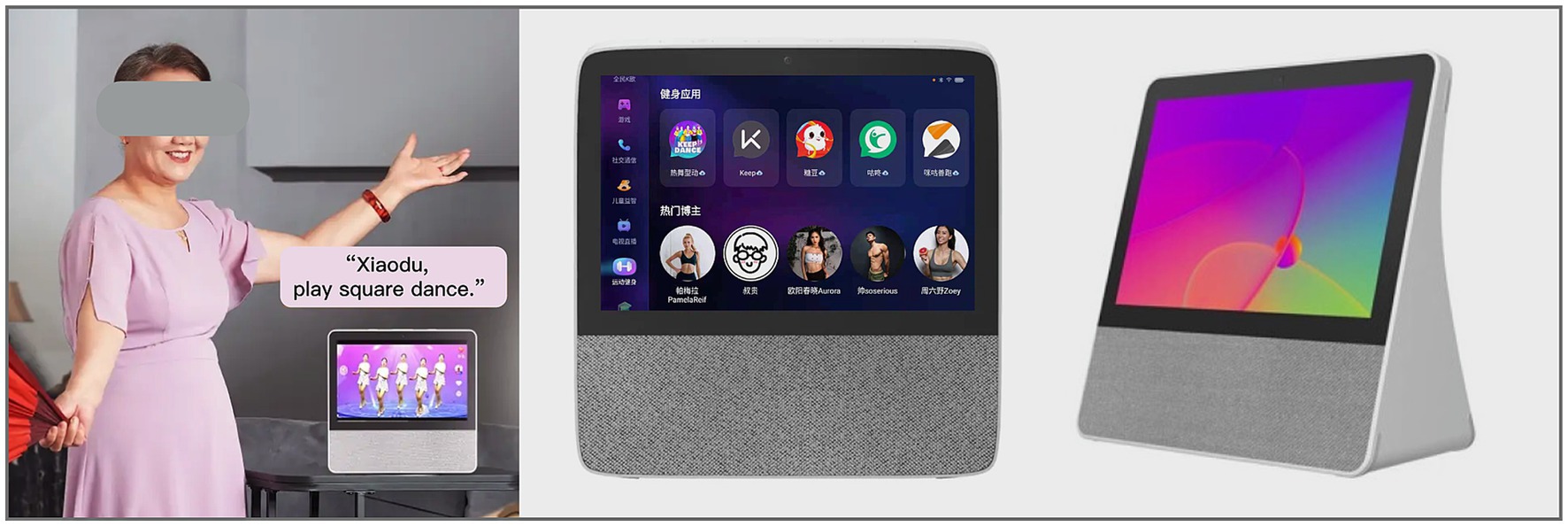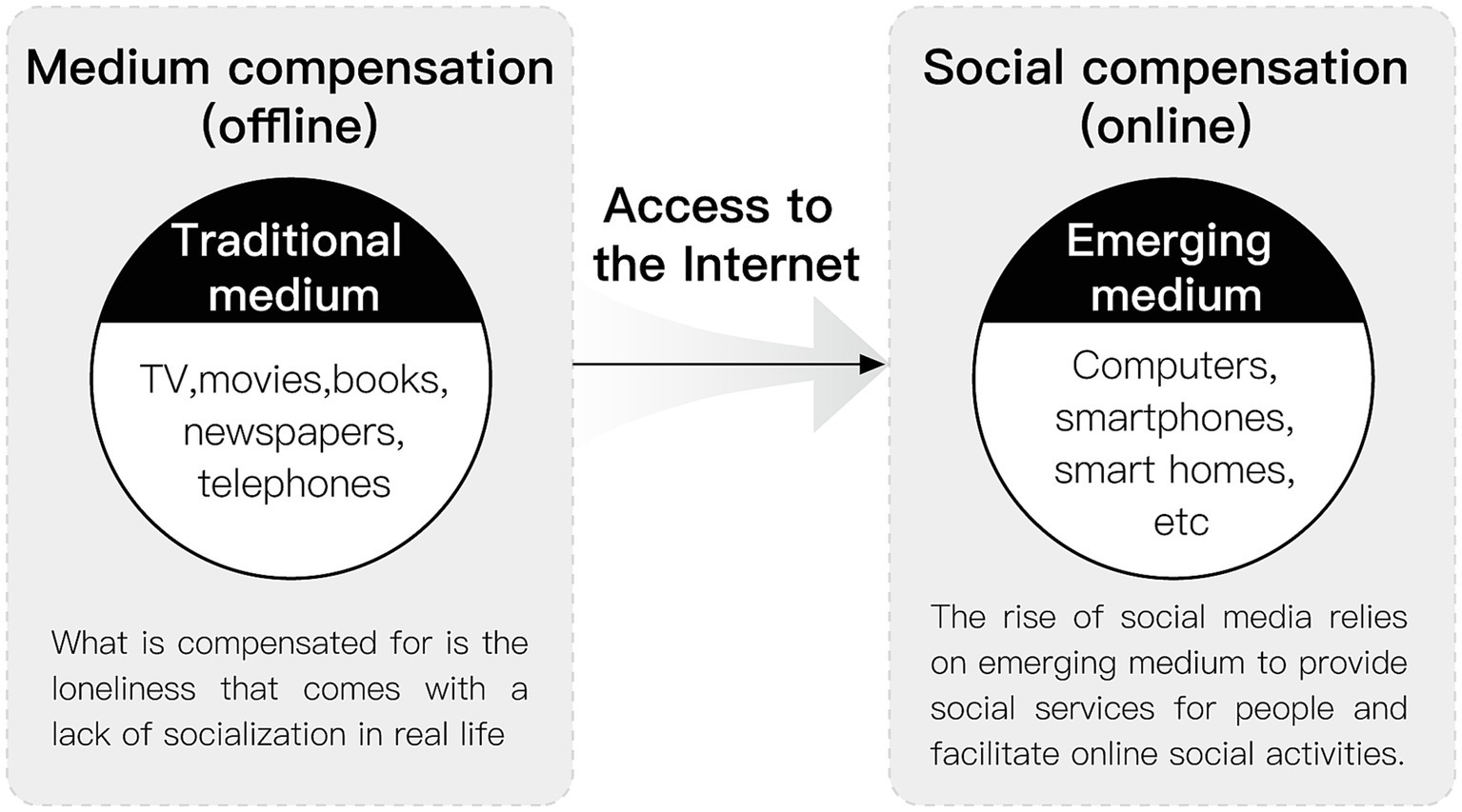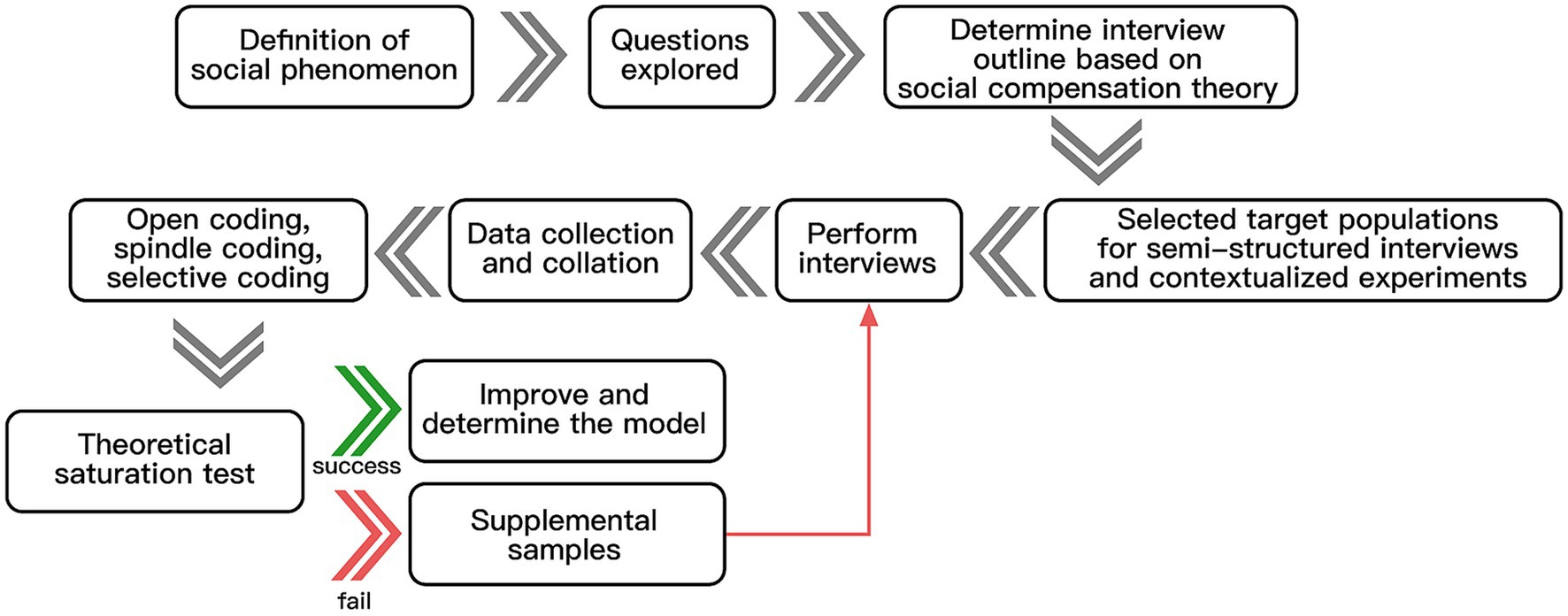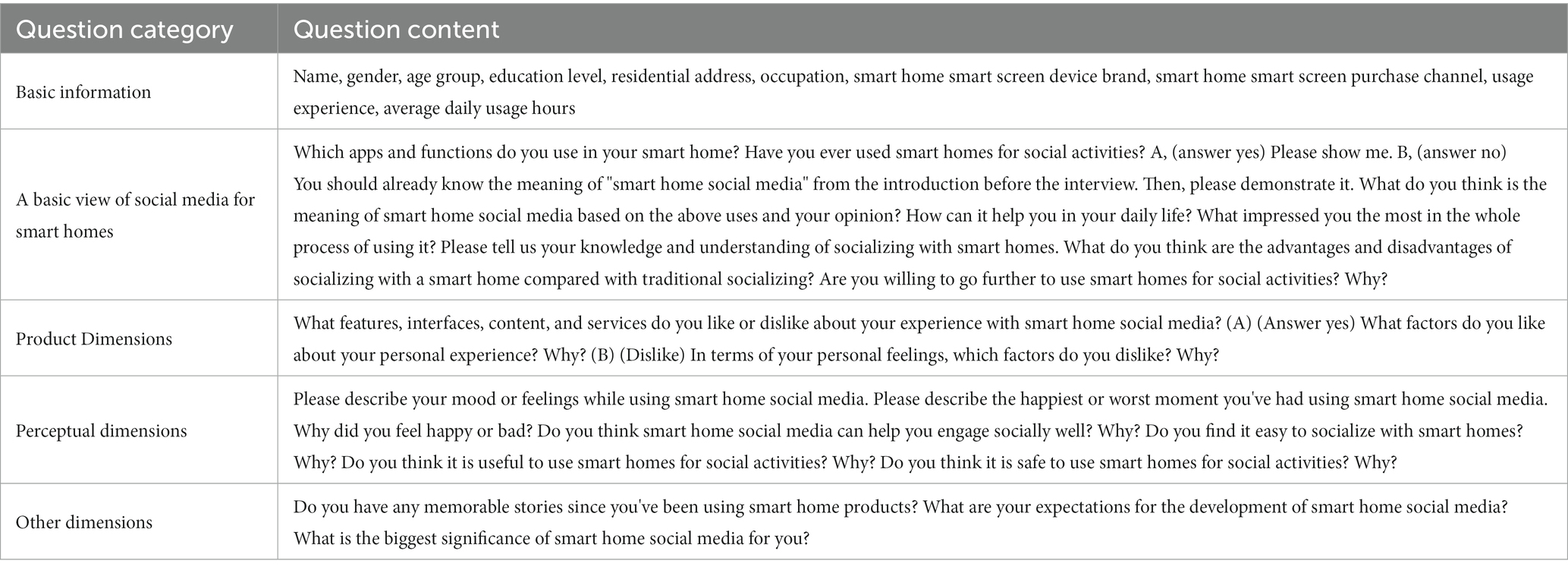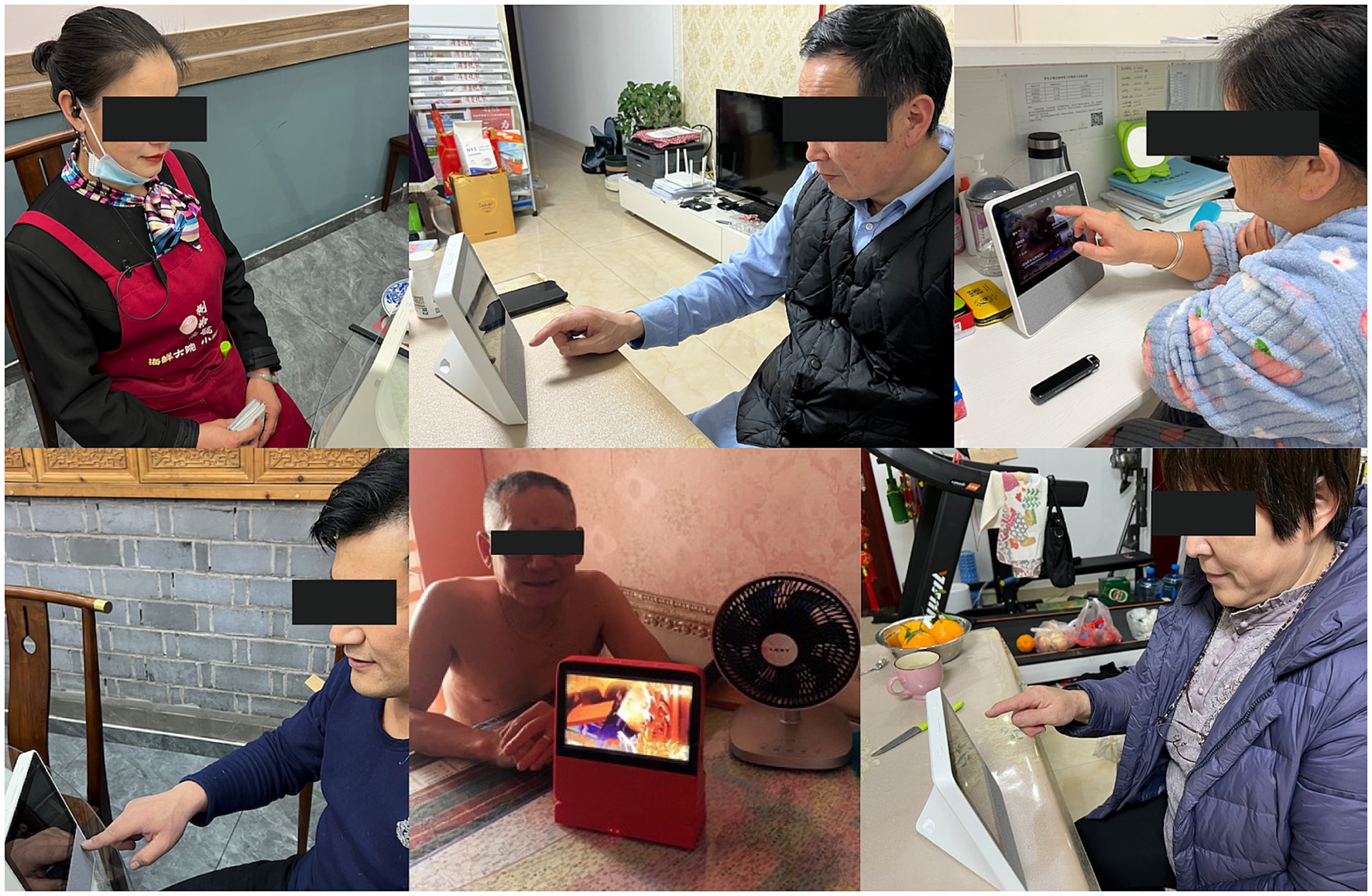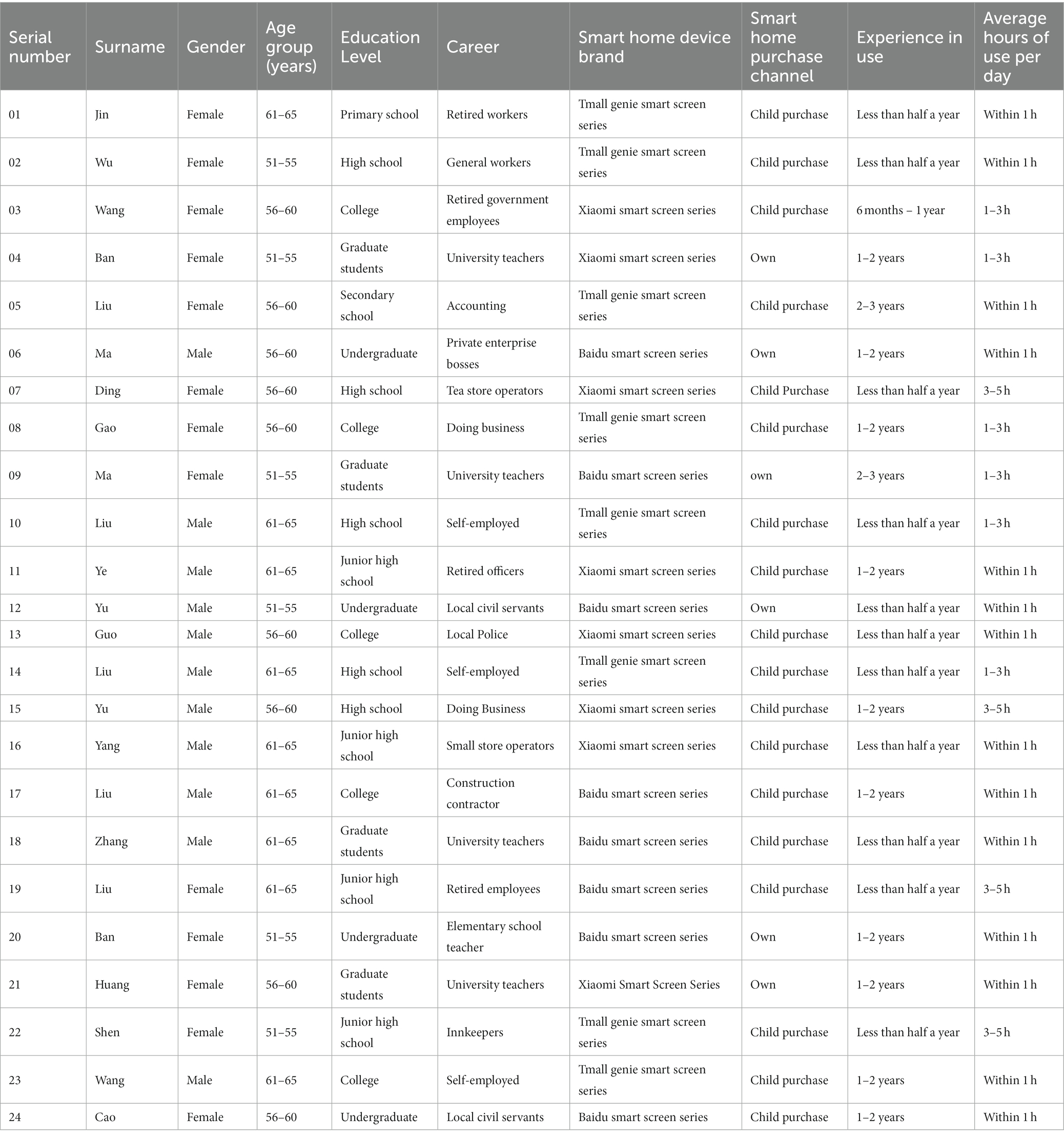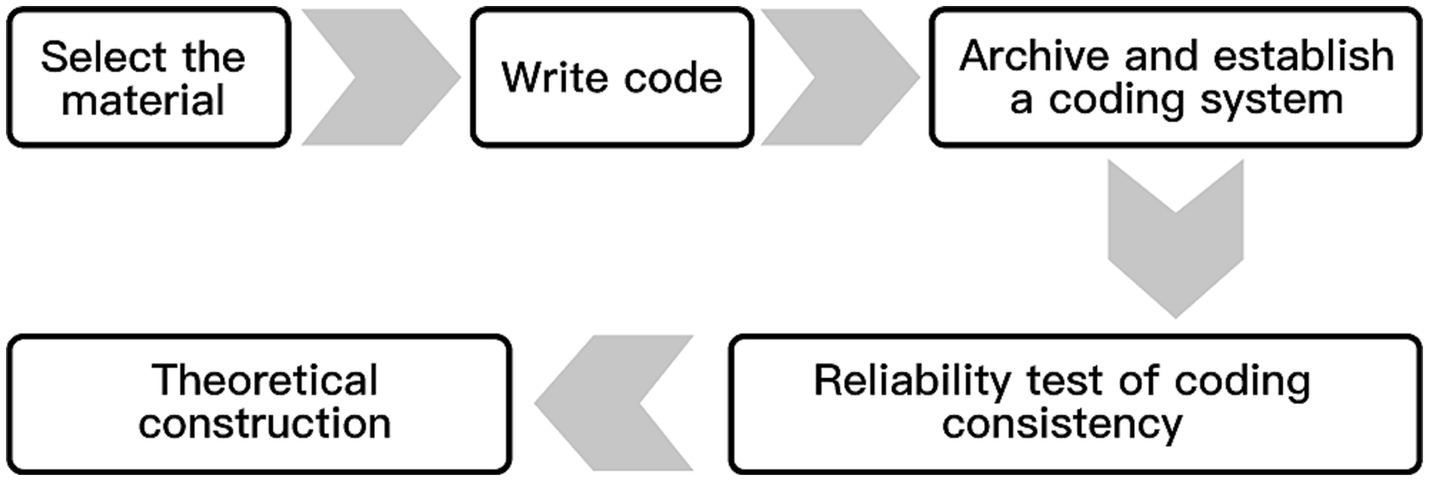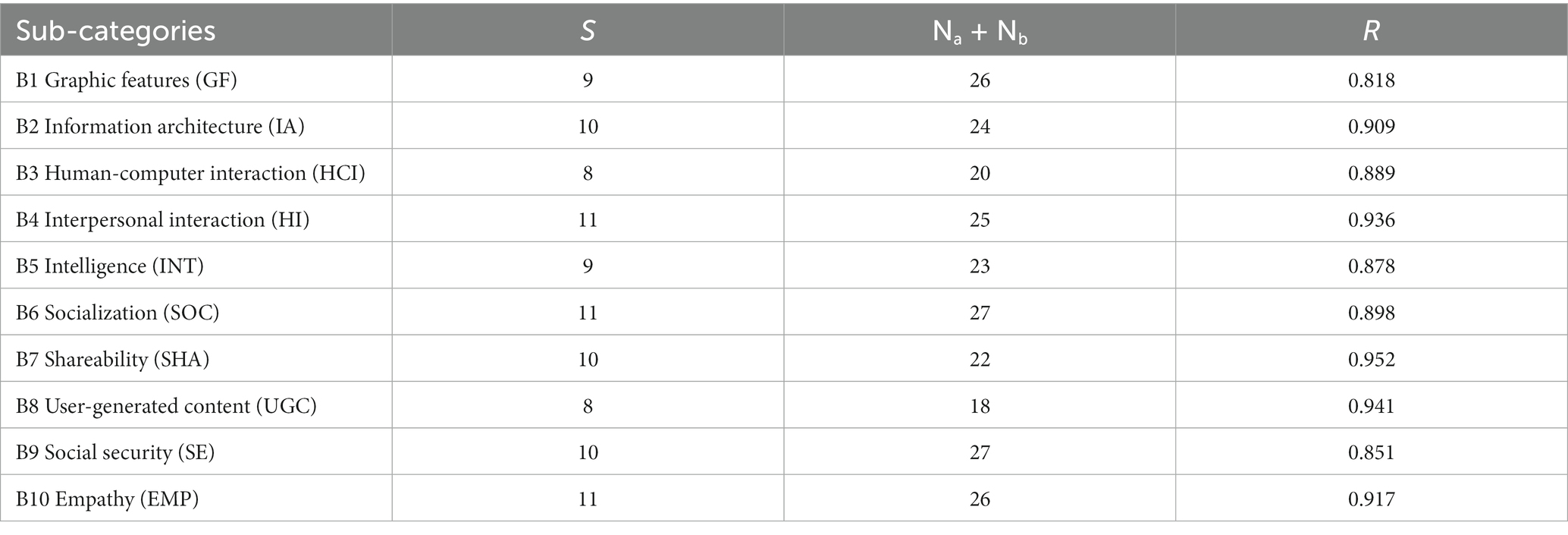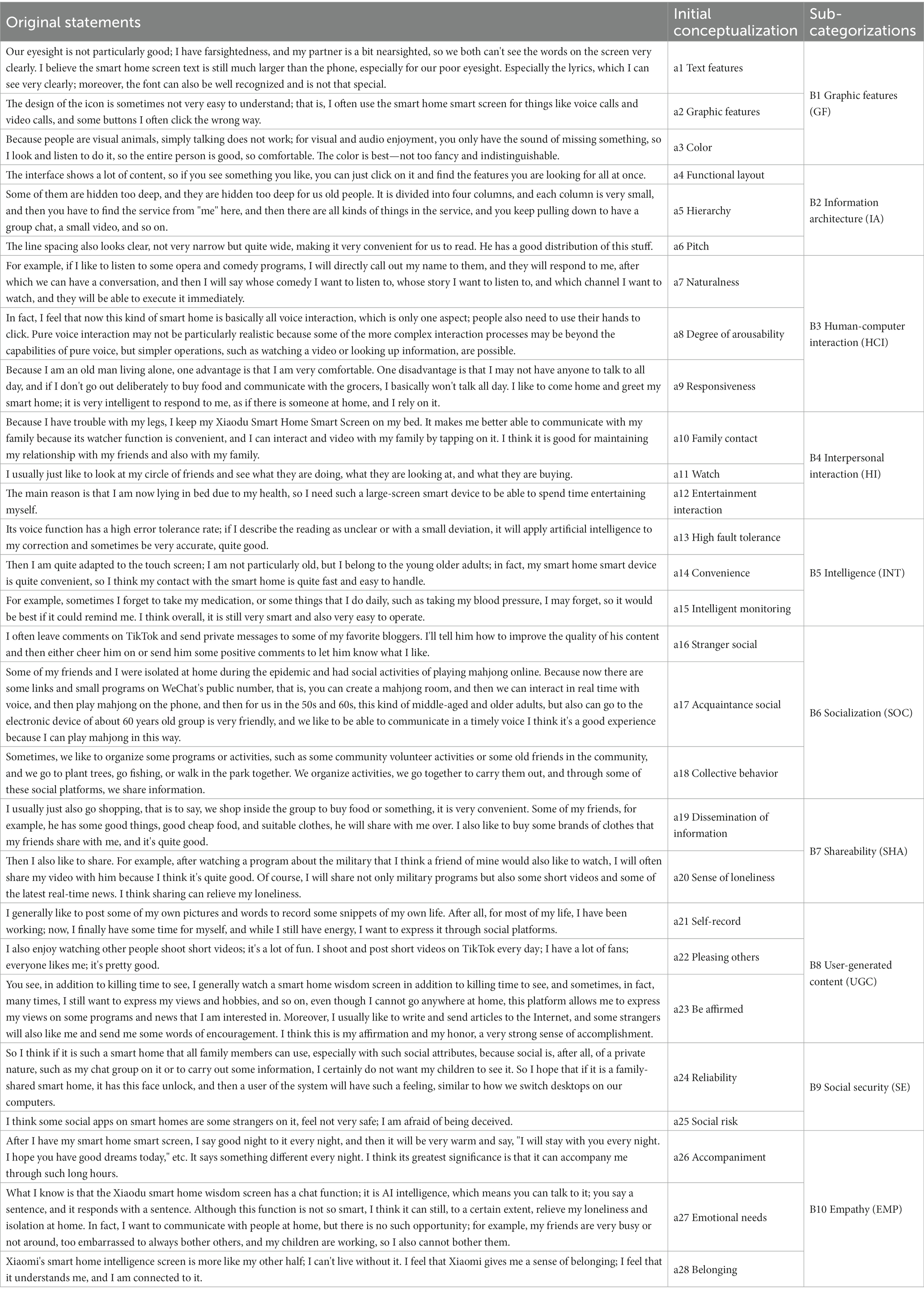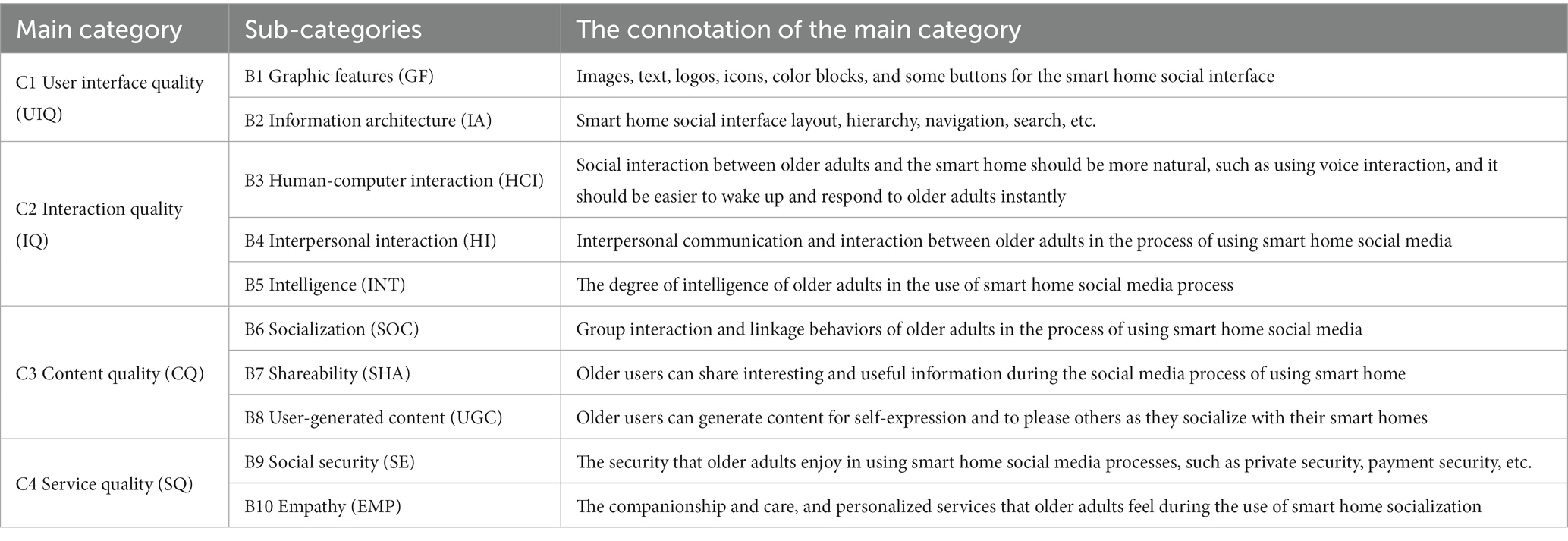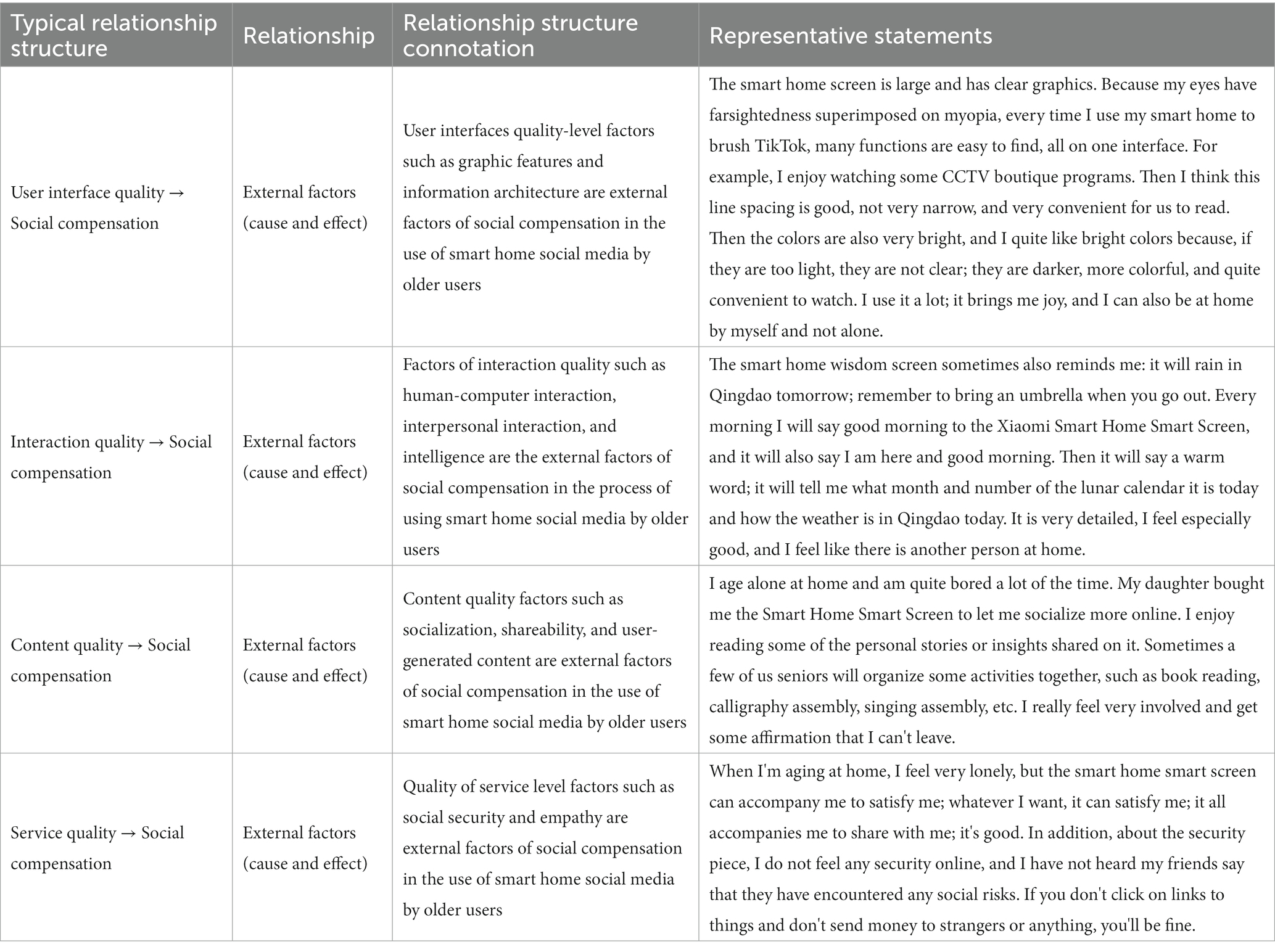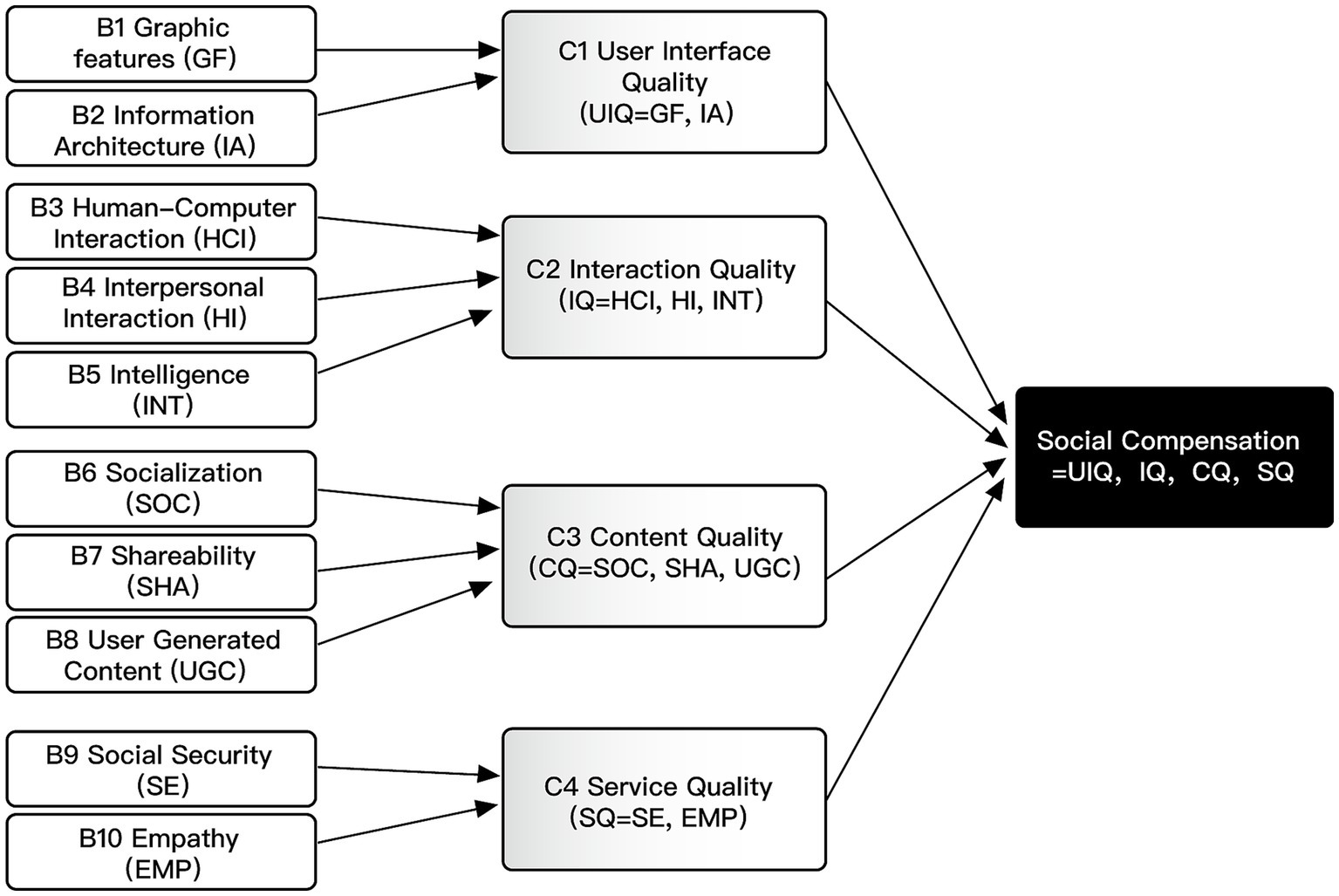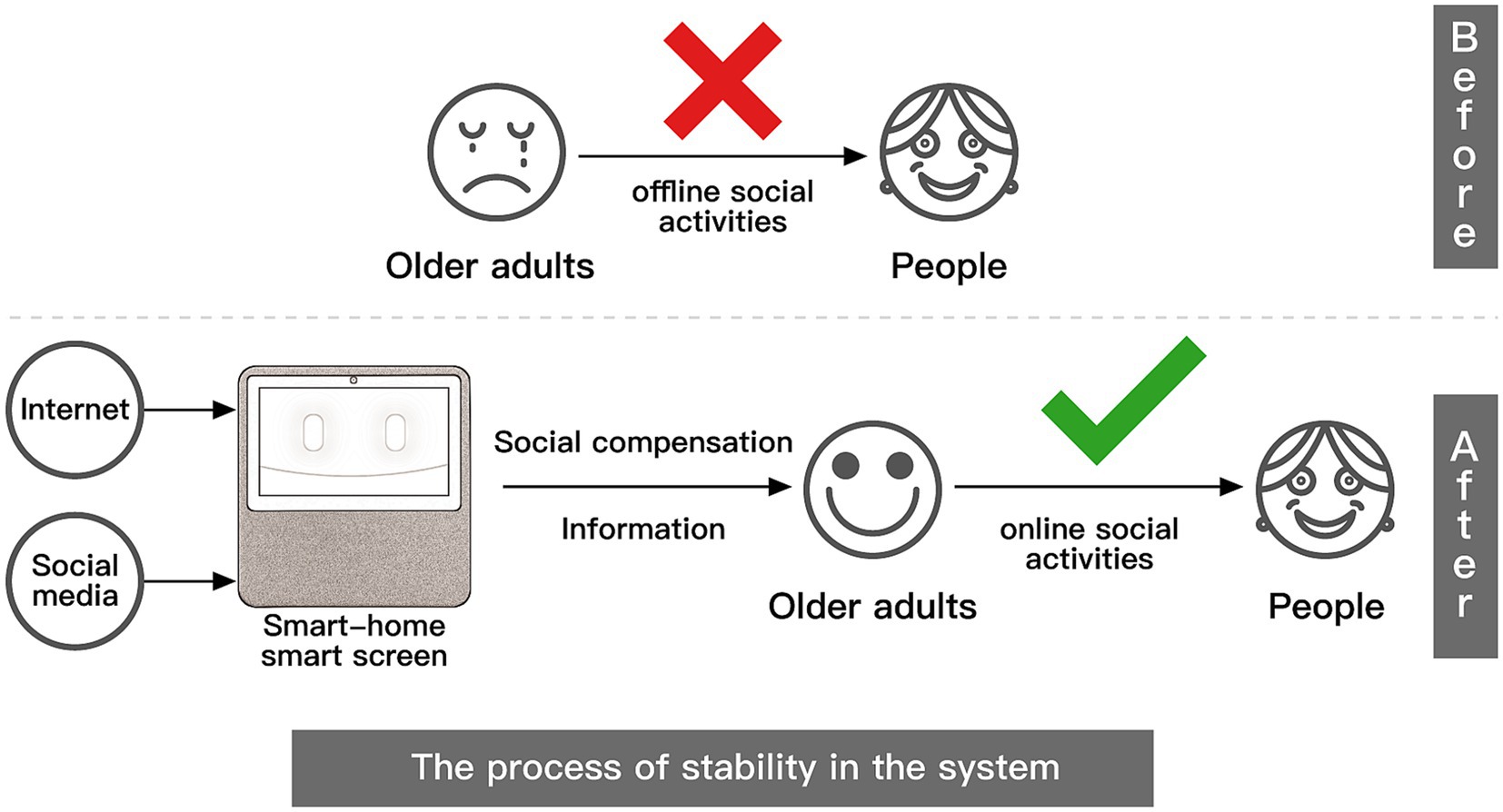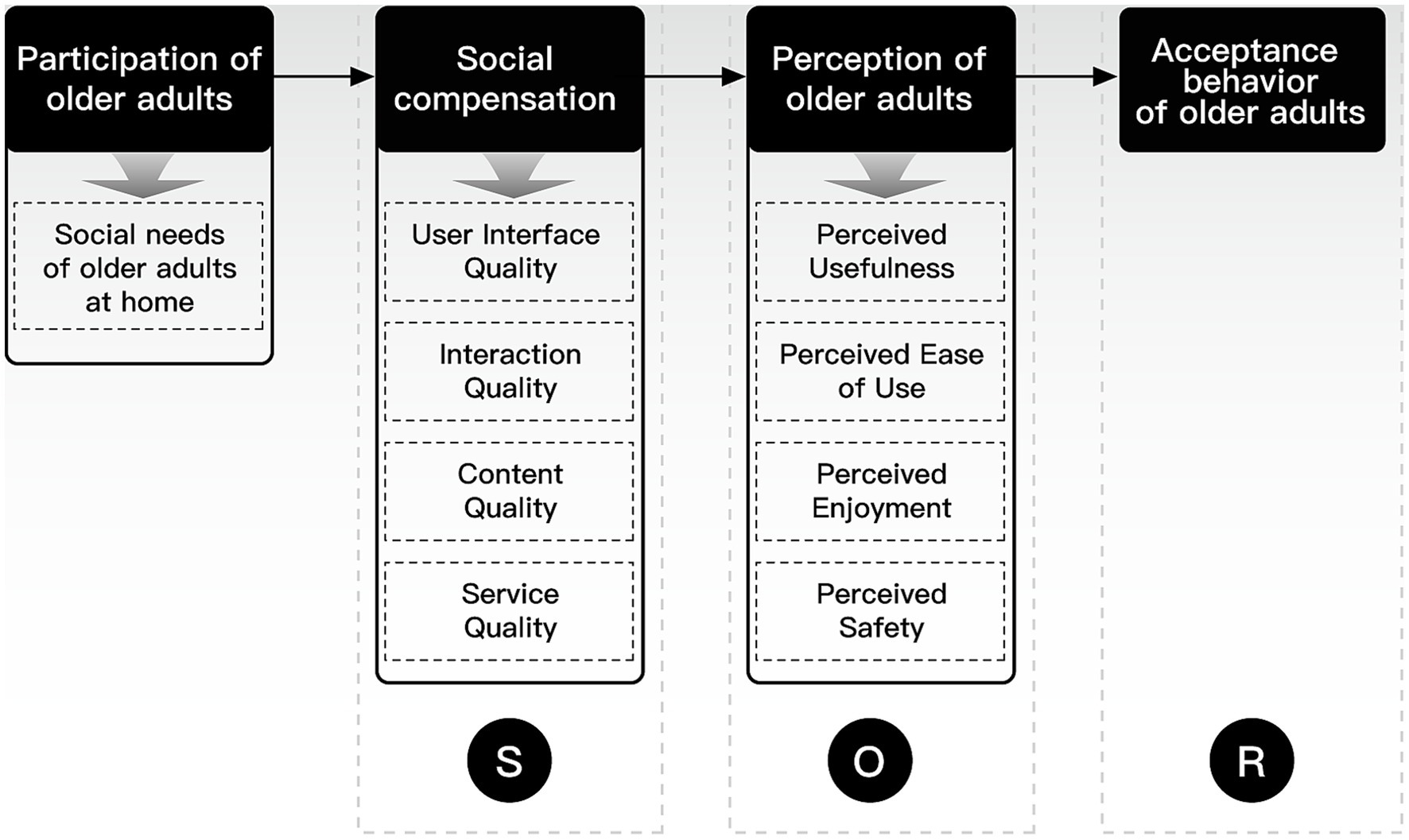- 1School of Design, Hunan University, Changsha, China
- 2Design Department, Politecnico di Milano, Milan, Italy
As a new generation of necessary terminals for future homes, smart homes have become one of the essential mediums for smart aging at home. This paper aims to explore how older adults who age at home can overcome the digital divide of the new medium and achieve social participation in the home context to realize active aging. Based on the theory of social compensation, we select the smart-home smart screen, a representative new medium product in China, and carry out open coding, spindle coding, selective coding, and theoretical construction of the original interview data through the grounded theory research method. The results show that the main factors affecting the social compensation of older adults to smart home social media include user interface quality, interaction quality, content quality, and service quality, and these four factors are used as external variables to compensate older adults socially, thereby stimulating the emotional experience and perception changes at the cognitive level of older adults and then affecting the adoption and acceptance of smart home social media by older adults. This study refines the factors influencing the older adults’ use of smart home social media from the perspective of social compensation. It explains the mechanism of acceptable behavior of older adults, bridging the gap in previous literature on the influencing factors and behavioral mechanisms of older adults of smart home social media. This paper provides a theoretical basis and guidance for the subsequent academic research and software development practice of social media under new technological devices to further help older adults in China achieve active and healthy aging.
1. Introduction
China is in the midst of an aging and digitalized society. On the one hand, China’s aging problem is severe, and the seventh national census of China, released in May 2021, shows that 18.7% of the total population, or 264 million people, are aged 60 and over, up 5.44% from the sixth census (1). Among them, the number of older adults living alone and empty nesters increased to 118 million, and it is expected that the number of empty nesters will exceed 200 million by 2030 (2). At the same time, the lower-aged older adult population aged 60–69 accounts for 55.83% of the total number of older adults, or about 10.44% of the total population (3). This is a significant increase in the number of older adults in China. The current situation in China is that the aging population continues to rise, with a large proportion of older adults living alone, empty nesters, and a high proportion of young older adults. To solve the problem of aging the first step is to solve the problem of old-age care. Since the pension model adopted in China is a “90-7-3” home-based care pattern (4), 90% of older adults aged 60 or above live at home. The remaining 10% choose daycare home-based services, and only a few attend institutions. Thus, more than 90% of older adults in China live at home. The main issue confronting a large number of older adults living alone and empty nesters is how to meet their social participation needs. Social participation is a fundamental factor that affects whether older adults can live independently and actively (5). Older people themselves are also willing to spend time maintaining contact with family and close friends (6). However, due to the decline in physical functions, mobility difficulties, retirement from the workforce, shrinking social circles, the impact of the post-epidemic era, as well as the need to cope with the sadness caused by widowhood and the loss of loved ones and friends, the above personal and social factors can lead to a lack of social interaction between the older adults and the rest of society, resulting in social isolation. They may feel lonely and emotionally unsupported, which can be psychologically damaging. Loneliness is associated with and synergistic with depression, reducing older adults’ well-being (7). Loneliness also increases the risk of death in older adults (8). Studies have shown that social interaction and participation in social activities can not only help alleviate social isolation and loneliness in older adults (9), but also help reduce the risk of Alzheimer’s disease (10). Therefore, how encouraging the social participation of older adults living alone at home has become an important practical issue.
On the other hand, as technology has advanced, China has entered an era of digitalization and intelligence, which has sped up the process of intelligent innovation in the household unit system. The smart home smart screen series is a kind of smart home product that began to rise in China in recent years (Figure 1). Smart homes are easier for older adults to use as AI personal assistants than smartphones. Voice interaction lets older adults control smart homes for social behavior even if they do not know Chinese characters. At the same time, technological advances have made smart aging an inevitable trend. In 2022, China’s State Council put forward the requirement of promoting technical and intelligent upgrading of older adults’ products and requested further promotion of competent services to adapt to the needs of older adults and build an intelligent society that takes the needs of the older adults into account (11). As a new means of older adult care, smart older adult care has become a helpful initiative to cope with China’s aging society (12). Smart home products are becoming increasingly popular, and their relative ease of access, low cost, and application in home scenarios make them one of the most critical products for smart aging. Intelligence and digitalization play an essential role in helping older adults improve their lives (13, 14). The use of smart homes has the potential to enhance the social participation of older adults and enable them to play an active role in smart wellness at home. However, older adults’ physical and psychological uniqueness makes them reluctant to embrace new technologies and products. Studies show that the most common reasons for older adults to withdraw from using the Internet are psychological and health barriers (15), making it difficult for them to enjoy the convenience of new technologies and products. China’s State Council points out the huge digital divide facing China’s older adults (16). Since smart homes are relatively new products, the digital divide makes the adoption and acceptance of using smart homes for online social behavior by older adults a topic worth exploring and studying. Providing a better design of smart home social software for older adults to make them have a better user experience can give inspiration to effectively solve the digital divide problem of older adults (17, 18) and thus enable smart aging for older adults and practice active aging. However, few studies have investigated the factors and mechanisms influencing the adoption of smart home socialization among older adults.
Therefore, predicting the acceptance of older adults to use smart home social media becomes very important, and accurately capturing the factors that influence the use of smart home social media by older adults is an important topic. However, it is not entirely clear what factors affect older adults’ use of smart-home online social networks. Due to the different usage contexts, application areas, and target populations, it is not possible to directly adopt the existing information system’s influencing factors to improve the acceptance of social behavior among older adults based on smart home social media, which is not only unscientific but also may not be effective. Therefore, this paper aims to uncover the theory behind the phenomenon and conduct further inductive analysis to build a theoretical model by systematically launching an exploratory study on the influencing factors of social compensation of social media use by older adults and its mechanism of action. To ensure that the influencing factors of social media use by older adults based on smart homes are more targeted and effective, we adopted the perspective of social compensation theory, based on smart home technology devices and with the help of the procedural grounded theory research method. Since social media use between older adults and social media includes individual emotional experiences and user feelings, it is difficult to collect the details of psychological changes in the process by cross-sectional quantitative research. In comparison, qualitative research methods are relatively more suitable for capturing the rich information on the corpus of factors influencing social compensation in using social media between older adults and social media. The advantage of qualitative research is that it can capture the dynamic psychological development process (19). This study aims to provide theoretical support and practical guidance for managers and developers of smart home social media platforms to improve the experience of older adults, achieve active aging, and enhance the well-being of older adults.
This study is innovative in the following aspects: First, this study introduces social compensation theory into the context of smart home social media usage, where previous studies have been based on cell phones and traditional media. Therefore, this study opens the research scope of social compensation theory to a more cutting-edge field and provides a new perspective for subsequent research. Secondly, this study innovatively unearths the social compensation factors affecting older adults of smart home social media, including the four aspects of user interface quality, interaction quality, content quality, and service quality. At the same time, it proposes the definition of social compensation in smart homes in the context of Chinese social media, reveals the intermediate process and results of psychological compensation of older users of smart home social media, explores the influence of social compensation on older users’ perceptions and older users’ acceptance behaviors, expands the relevant studies explaining the mechanism of older users’ acceptance behaviors from the perspective of social compensation, and makes up for the previous literature on the mechanism of older users’ acceptance behaviors. This provides a theoretical basis and guidance for the subsequent academic research and software development practice of social media under new technological devices.
2. Literature review
2.1. Social compensation
The term “compensation” is derived from the medical study of the human senses. It is widely discussed in biology and medicine as a biological (including human) physiological mechanism by which the body establishes new stability by adjusting the function, structure, and metabolism of organs and tissues after an internal imbalance. Since the introduction of compensation into psychology, its concept has played an essential role in various fields of psychological research, from the field of neuroscience to the study of aging to aspects of interpersonal interaction. Social compensation theory originated in the 1980s when Davis and Kraus, two scholars, studied the relationship between social behavior, mass medium use, and loneliness, which refers to the fact that the medium can compensate for people’s lack of social connection (20). At that time, the study focused on the more traditional mass medium, such as newspapers, movies, and books, and the mass medium in the study compensated for the psychological loneliness caused by the lack of social interaction in real life. With the further development and popularization of Internet technology, the medium changed from traditional mass mediums to emerging mediums such as smartphones, computers, and smart homes. In this type of emerging medium, social media is sprouting up like a spring. Social media is an Internet-based platform for people to share information and opinions with each other, and the local social media in China mainly include TikTok, WeChat, Little Red Book, Quick Worker, and Micro Blog. They rely on social media to provide social services for people and facilitate their online social activities. Therefore, medium compensation includes a relatively more diverse range of mediums, such as television, music, telephone, SMS, and even media channels not connected to the Internet, such as tapes, which can play a compensatory role (21); In contrast, social compensation is more of a distinction between offline in-person communication and online communication through the medium, mainly referring to the emerging medium carrying social media that are used to compensate for the psychology of loneliness caused by the lack of social relationships of different groups under the popularity of the internet (22) (Figure 2). Social compensation theory suggests that people who have difficulties in offline, face-to-face communication will compensate for offline deficits by means of online communication (23, 24).
Strengthening compensation interventions for older adults is critical to active aging (25). Social compensation research has attracted academic attention, and more and more scholars have attempted to use social compensation in the social interaction of older adults because more and more older adults at this stage are using social media under social networks to engage in social participation through an emerging medium. The use of social media by older adults for social participation is conducive to improving their positive emotional experience and life satisfaction and further has a positive impact on health (26–29). Online social activities through mediums such as cell phones allow older adults to have higher levels of social support and social connections (30). In a study of social compensation based on smartphone use contexts, older adults who stay connected to their friends and family through smartphones can achieve higher levels of well-being (31, 32). The study found that older adults can gain more social recognition by expanding their interpersonal circle and following new trends, which makes them emotionally fulfilled and emotionally compensated (33). This allows them to be emotionally satisfied and compensated. Through the use of WeChat (browsing friends’ updates, etc.), older adults can enhance their interaction with friends and relatives and their sense of identity and belonging, regardless of time, space, and physical constraints (34). Studies have found that WeChat has become the most popular social app among older adults in China (35). Social media apps have become a way of life and a norm for them (36). However, unlike smartphone-based social compensation research, which started earlier and has yielded fruitful research results, social compensation research on social media use among older adults in the context of smart homes is scarce. Therefore, relying only on the collation and categorization of influencing factors from the existing literature does not provide an accurate understanding of the actual social compensation factors and barriers to smart homes among older adults. More relevant research is needed to understand the preferences of older adults in using social media (37). The study of older adults’ willingness to use smart homes for online socialization is still a relatively new concept. This is because, along with the digital and intelligent development of home systems and the rise of smart home screens, the social compensation of older adults’ use of smart home social media has become a research hotspot and has received much attention due to whether older adults adopt and use it. Moreover, social compensation depends to some extent on the choice of medium, and the internal mechanism of social compensation is different for different mediums due to the different characteristics of each medium, which are determined by the characteristics of the medium itself. Obviously, the study of the factors and mechanisms influencing the social compensation of social media use among older adults based on the smart home context is a forward-looking trend that no researcher has yet described and measured from a process perspective. Therefore, its theoretical development and commercial practice need further research and exploration.
2.2. Acceptance behavior of older adults on social media
Previous research has discussed the behavior of technology adoption and acceptance among older adults of social media from the information systems perspective. A central perspective in this area is the Technology Acceptance Model (TAM) proposed by Davis (38), which can be used to explain the problem of low information system usage. TAM has been widely used to evaluate and predict whether user will accept information systems or technologies. With further development, TAM has been extended with different new models by combining other theories, and research on related theoretical models is a very active and widespread class of topics in the field of information systems. At the same time, TAM has been shifted from the general population to focus on specific populations, and models such as TAM2, TAM3, UTAUT, and UTAUT2 have been applied to the technology acceptance behavior of older adults of social media one after another (39–47). For example, Su and Tong (39) used UTAUT2 and ECM to investigate the cognition and use of social networking technology among older Chinese adults. Through a questionnaire survey of 323 older adults, the results showed that performance expectations, facilitating conditions, social influence, and hedonic motivation all had a significant positive impact on perceived value, and perceived value and satisfaction also had a significant positive impact on the willingness of Chinese older adults to participate in social networking technology. Braun (40) surveyed 124 older adults using TAM to explore what factors encourage or discourage older adults’ willingness and motivation to use social networks and found that perceived usefulness, trust, and frequency of Internet use of social networks can significantly predict social network use, related to similar studies such as Pan and Jordan-Marsh (48). In addition, a technology acceptance model specifically for older adults, STAM, has been proposed (49). It can be seen that TAM is widely used in the investigation and analysis of the usage behavior of older adults’ social networks, showing strong prediction and interpretation capabilities.
2.2.1. Variables of acceptable behavior of older adults on social media
The definition of technology acceptance covers a wide range. The current research focuses on four types of social media acceptance behaviors of older adults: adoption or actual use (50), intention to use or behavioral intention or intention (51), general acceptance (44), and intention to continue using (52). In terms of variables, scholars have conducted studies on the adoption and acceptance of social media by older adults in different aspects: firstly, the demographic characteristics of older adults have received extensive attention (53), such as gender, age, education level (54), physical condition, race (55), and place of residence (56). For example, in order to investigate the factors influencing the use of online social networks by older Internet users in Slovenia, Vosner et al. (53) analyzed the collected data using basic descriptive, univariate, and multivariate statistical methods, the results showed that female participants were more familiar with the term “online social network” than male participants, in addition, age, gender, and education seemed to be the most critical factors that directly or indirectly affected the use of online social networks by active older Internet users; second, social factors dimensions also occupy the research heat, such as social capital (50), risk barriers (57), social influence (40, 44, 58). For example, Wilson et al. (50) used a qualitative and exploratory approach to conduct semi-structured interviews with 20 older adults (over 65) in England, Scotland, and Wales. They found that lack of social capital, physical functions, and online communication culture were barriers to older people’s adoption of social media. Choudrie and Vyas (57) used an online questionnaire and PLS-SEM to conduct data analysis in order to investigate the influencing factors that affect older adults’ adoption of online social networks. The survey results showed that significant privacy protection and other factors affect older adults’ adoption of Internet technology in family situations. In order to explore the antecedents and related results of multi-social media use among older adults, a quantitative and qualitative study of 242 and 26 Taiwanese adults aged 60 and above, respectively, Yu (58) found that social forces (influence from children, friends, and the public) are the core factors influencing the adoption of instant messaging apps and social networks among older adults.
In addition, technical factors (at the product level) are also the focus of research pursuits, such as system support, user interface design and navigation (45, 59), system complexity (60), and technology compatibility (61). For example, Nimrod (60) proposed and developed a new scale to measure technical stress in older adults, which includes five constructs and 14 measurement items. Zhou (61) collected valid data on 726 older adults to explore the factors influencing the use of social networking sites among older Chinese adults and proved that factors such as technological compatibility and comparative advantage promoted the use of social networks among older people. Finally, some scholars have conducted research from certain specific theoretical perspectives, such as the time-theoretic perspective (52), uses and gratifications theory (62), media richness theory (63), innovation diffusion theory (61), innovation resistance theory (64), social network theory (65), and planned behavior theory (66). Lai and Chong (52) explored whether current and future time and their interaction with perceived values can explain the intention of older adults to continue participating in social media from the perspective of time theory. They collected responses from more than 400 older adults and constructed SEM for analysis. The results show that time perspective affects different perceived values, affecting the continued willingness to participate in social media for healthcare-related purposes. Kim et al. (46) applied the uses and gratifications theory and innovation diffusion theory to explore the motivations of older adults to use mobile social networking sites for travel, and the results show that both have a more significant impact on real experience than on-site attachment. Yang and Lin (63) integrated the uses and gratifications theory and media richness theory to study what factors make older adults willing to adopt ubiquitous mobile social services. Through an empirical study of 226 older adults, it was found that social, enjoyment, and fashion motivation have an impact on older adults’ adoption of ubiquitous mobile social services. In addition, the user’s perceived richness of interaction and application self-efficacy also significantly impact older adults’ adoption of the service. Ellis et al. (66) used planned behavior theory to explore the factors influencing technology adoption among older adults in Taiwan. The study found that emotions, friends’ influence, and technology comfort significantly affect intention and use.
The above-mentioned qualitative and empirical studies highlight that many scholars have conducted studies on the variables of social media-based acceptance of older adults’ information behaviors. The antecedent variables include personal, social, and technological factors and specific theories. However, the use of social compensation theory as an antecedent variable to explore the acceptance behavior of older adults’ social media use from a smart home perspective has not yet received attention and validation. Our research will investigate these issues.
2.2.2. Technological devices used by older adults to adopt social media
In terms of applied technology and devices, scholars have studied the information behavior of older adults using social media mainly on computers (40, 44, 57, 62, 64, 67), smartphones (43, 46, 51, 58, 63, 68–70), social robots (71), wearable products (47), and tablets (72). These five major categories of technology and equipment vendors have been targeted for research. For example, Ma et al. (43) explored the influencing factors that affect the acceptance of smartphones by older adults in China. Using TAM and UTAUT, they conducted structured interviews and questionnaires with 120 older adults to develop an SEM. The results showed that those who are young, have received higher education, are not widowed, and have better economic status in terms of salary or family support are more likely to use smartphones. In order to explore the acceptance of social robots among older adults with dementia, Chen et al. (71) used a randomized controlled trial to evaluate the acceptance of technology. One hundred and three older adults were divided into two groups. In the experimental group, nursing personnel observed and recorded the interaction process between older adults and social robots, and then older adults filled in a questionnaire. The results showed that at week 32, the perceived ease of use in the experimental group improved compared to the conventional care group. This study supports the interaction of older adults with social robots that can improve the ease of use of technology. Talukder et al. (47) proposed an integrated theoretical model to predict the external determinants of older adults’ acceptance of wearable healthcare technology (WHT), integrating UTAUT2 with resistance to change, technological anxiety, and self-realization. Through SEM research and neural network validation on 325 older adults, the results showed that social impact, performance expectations, functional consistency, self-realization, and hedonic motivation were positively correlated with WHT adoption. Chen et al. (72) investigated the acceptance of tablet technology among older adults with cognitive impairment at the personal and situational levels. Using a questionnaire and focus group, they completed this 8-week family awareness training by providing tablets to 57 older adults in Hong Kong. The training results were evaluated through a questionnaire survey. The results showed that attitudes towards tablets and convenience conditions were predictive factors of older adults’ willingness to use tablets.
As can be seen, with the further development of technology, the applied technologies and devices targeted by the study are constantly updated, from the initial research on the acceptance of computers by older adults in the context of social media to smartphones, tablets, wearable products, and social robots. We know that the properties of different technological devices vary widely. The emergence of new technologies and devices has left important questions about the factors influencing the adoption behavior of older social media users and the mechanisms at play that still need to be further explored and urgently addressed. The specific reasons for this can be divided into two points. First, smart home smart screens belong to a new category of smart home product forms. Studies have shown that older adults are more willing to use new technologies and services in the home environment (73). Second, in the context of social media use, the willingness of older adults to adopt new devices and technologies to socialize online is entirely voluntary. They can easily refuse to accept new devices and technologies because of a device-technology-product-level factor. Therefore, the commitment of older adults to accept the use of new technologies and devices is significant to new device social media developers. However, research related to the factors and mechanisms influencing the acceptance behavior of older adults of new devices and technologies, such as smart screens for smart homes, is minimal and is not currently addressed in the relevant literature. Therefore, there is an urgent need for research on the social compensation of social media use by older adults in smart home contexts.
3. Research methods
Barney and Strauss, two professors at Columbia University, developed the grounded theory method in 1967. Corbin and Strauss (74) developed the grounded theory procedurally; they conceptualized and categorized the survey data step-by-step and divided the coding into open, spindle, and selective. The three steps are to distill the original data (speech, text, etc.) into initial concepts and initial categories, further excavate the connections between the initial categories to inductively deduce the main categories, and finally analyze the relationships between the main categories and form a relevant theory rooted in the actual data. In the whole analysis process, it is necessary to constantly compare, argue, and refer to the existing relevant literature to avoid substituting the coders’ subjective ideas so that the new theory formed by rooting can respond to the essence and meaning of social phenomena, as shown in Figure 3.
3.1. Interview outline
The interview questions should not try to lead the interviewees in a specific direction. Instead, they should try to get as many opinions and relevant details about the research topic from the interviewees as possible. The interview outline is based on the desktop research data and will be fine-tuned appropriately according to the interview content. It contains two major parts: basic information and interview question content (Table 1). The interview content focuses on four aspects: basic views on smart home social media, product dimensions, perception dimensions, and other dimensions.
3.2. Samples
Our study selected the smart home smart screen as an emerging medium object. It serves as a new Chinese home media terminal platform that retains the functions of smart speakers, such as voice control and manipulation. It also carries out human-computer interaction with users through a sizeable touchable screen that can carry out operations such as video calling, online chatting, listening to songs and catching up on dramas, and life assistants. Alibaba officially launched its first smart home smart screen product, Tmall Genie CC, in April 2019, and subsequently, brands such as Baidu, Xiaomi, and Huawei have also released their own smart home products equipped with smart screens. There is no consistent standard regarding the age division of older adults. According to China’s population retirement age, women are 50 or 55, and men are 60. Meanwhile, the American Association of Retired Persons (AARP) also describes seniors as those aged 50 and above (75). Based on this, the target population defined in this paper is users of smart home social media aged 50 (inclusive)–65 years old, which is also consistent with the setting of other recent studies (46, 76, 77). We made this choice because using smart home social media was a prerequisite, and participants had to be active Internet users. Young older adults are more digitally literate and willing to use new and trendy smart devices than other age groups. We believe that our findings can be generalized to other age groups of seniors as more seniors join in using smart home social media.
The user group for this data collection was mainly searched through the snowball sampling method, using a semi-structured interview method and contextualized experiment (allowing the target group to use the product) as the two primary forms. The interview period was from September 8 to November 12, 2022, with a total of 24 interviewees (11 males and 13 females). 14 were conducted online through the WeChat video function, and 10 offline. Face-to-face and in-depth interviews allowed asking older adults to use the smart home social app on-site for online socialization and other activities (Figure 4). We also recorded some information through the participant observation method. The interview time was about 30–50 min per person, and it was conducted within 1 h to ensure continuous and uninterrupted availability for both parties and avoid other factors’ interference. Before the interviews, a bonus package ranging from 30 to 50 RMB was offered to the interviewees to motivate them to participate actively and ensure more valuable content for the study. The respondents were introduced to the background, purpose, process, and related terms and concepts of the interview and its academic goal. The respondents signed a user-informed consent form, to protect their data and permit audio recordings. Voice data were textualized with the help of Xunfei Hearing’s speech-to-text assistant. The textualized data were named as “number/respondent’s name/year, month, and day of the interview.” A total of nearly 80,000 words were formed to facilitate the post-coding of the interview text. In this paper, the 2/3 (16 textual materials) were chosen randomly for the grounded theory coding analysis, and the other 1/3 (8 textual materials) were used to test for theoretical saturation. The basic information of the respondents is shown in Table 2.
4. Research process
4.1. Data analysis method
This study used NVivo, a tool for qualitative analysis made by QSR, to process the collected textual materials and interview data. We (the researchers) could store and code the data in a logical order with the help of the software. NVivo’s main processes for processing interview text data are as follows: selecting materials, writing codes, archiving and establishing a coding system, testing coding consistency and reliability, and theory construction (Figure 5).
4.2. Open coding
Open coding is a refinement and abstraction process that conceptualizes and categorizes raw interview material (78, 79). When using open coding, the researcher must follow a systematic and rigorous normative procedure to gradually extract and condense the large amount of data collected from the bottom up. Open coding requires categorizing the original data, assigning concepts to the original statements, naming them (using certain abstract concepts to explain the phenomena), and further analyzing and comparing them to merge similar concepts to form more generalized sub-categories. The coding process uses sentences as the smallest unit and labels to further ensure objectivity, refining the initial concepts.
4.2.1. Coding process
The coding researchers were screened to make sure that coding was done systematically. In the end, two graduate students interested in how people use information were chosen to do the coding for this study. Both coders had more than 1 year of experience using smart home terminals and they had also done user behavior research projects related to older adults. During the coding process, the two coders were given basic training based on the NVivo software to ensure they could follow the process and procedure of coding strictly. The two coders discussed using the code book’s basic rules to make a basic guideline for the coding process.
The open coding randomly selected 2/3 of the interview text materials, a total of 16, and first carried out the text normalization process, i.e., some repetitions, speech-to-text errors, etc., were manually proofread. Then two coders separately imported the normalized interview text materials into NVivo software as Word documents and conceptualized and categorized the text materials. The main process was as follows: by analyzing the interview text sentence by sentence, the statements that did not answer the substantive content were eliminated, and the original substantive statements were distilled into an initial concept and named. In the process of conceptualizing the entire interview text in this way, the newly created initial concept is repeatedly compared with the established initial concept, and if the newly created concept is not consistent with the meaning of any existing concept, then a new concept is created. In this way, the initial conceptualization of the interview text material is achieved.
4.2.2. Coding inter-rater reliability test
To ensure the accuracy of the coding, the two coders performed a coding inter-rater reliability test on the coding results of the open coding generation of the initial concepts and sub-categories. This computational evaluation process was continuously adjusted and repeated through the computational results until the reliability test reached an acceptable level. The formula for calculating the inter-rater reliability between two coders is shown in equation (1) (80):
In equation (1), the denotes the number of coders, and denotes the average agreement between the two coders, and the inter-rater reliability between the two coders is obtained by calculating . To get , the first requirement is the value. Calculate using the formula as shown in equation (2).
In equation (2), the denotes the number of categorically consistent codes for the two coders, the and denote the number of codes for each of the two coders, respectively. Finally, the inter-rater reliability between two coders is calculated according to equations (1) and (2).
After the initial conceptualization of the interview text by the two coders, coder A obtained 131 initial concepts, and coder B obtained 136 initial concepts. After repeated discussions, a total of 109 initial concepts were obtained by synthesis and generalization. As a result, applying equations (1) and (2), the inter-rater reliability between the two coders for the initial conceptualization was 0.898. Normally, if this value is below 0.5, then the data needs to be recoded; if the value is below 0.8, then the coding result needs to be further revised until it reaches an acceptable level of 0.8 or higher. After adjustment, the inter-rater reliability of the initial conceptualization was 0.898, which indicates that the initial conceptualization stage of open coding has high reliability.
Based on this, the two coders used NVivo’s node (initial concept) combination function to refine further and cluster the 109 initial concepts based on causality and similarity, and finally, coder A abstracted 12 sub-categories and coder B abstracted 14 sub-categories. After repeated discussions, ten sub-categories, numbered B1-B10, were synthesized and summarized, and then applying formulae (1) and (2), after calculation, adjustment, and evaluation, in the process of abstracting and generating each sub-category by the two coders, the consistent number of codes , the total number of codes and the inter-rater reliability of each sub-category are shown in Table 3. The inter-rater reliability of the open coding sub-categories was greater than 0.8, and more than half of them reached the excellent level of 0.9 or higher, so it can be said that the coding results passed the reliability test.
4.2.3. Coding results
In the open coding stage, two coders synthesized and abstracted 109 initial concepts to form 28 initial concepts, numbered a1-a28. The original interview representative statements, corresponding initial concepts, and sub-categories obtained by open coding are shown in Table 4.
4.3. Spindle coding
4.3.1. Coding process
Based on open coding, spindle coding is a further reconsideration and comparison of the initial concepts and sub-categories of development for inductive deduction (81). A management expert was invited to participate in the spindle coding and confirm the main categories in a real-time discussion with the two coders to ensure the results’ scientific reliability and rigor.
4.3.2. Coding results
By combining expert opinions and exploring the relationship between the above ten sub-categories, four main categories on the smart home social media level were further consolidated and obtained: user interface quality, interaction quality, content quality, and service quality are shown in Table 5.
4.4. Selective coding
Selective coding is the stage of extracting the core theme from the main categories. At this stage, we need to focus on the main categories, summarize and refine the main categories again, uncover the core theme that can cover other main categories by organizing the correlations between the main categories to maximize the unification, and construct a model to build up the relationship between the core theme and the main categories to determine the meaningful relationship between the core theme and the main categories (82).
This paper determines the relationship between the core theme and the main categories. The core theme of “social compensation” was finally extracted through repeated research, comparison, and analysis of the four main categories. This core theme includes four main categories: user interface quality, interaction quality, content quality, and service quality. User interface quality is influenced by two key factors: graphic features and information architecture; interaction quality is influenced by three key factors: human-computer interaction, interpersonal interaction, and intelligence; content quality is influenced by three key factors: socialization, shareability, and user-generated content; and service quality is influenced by two key factors: social security and empathy. The typical relationship structure, the connotation of relationship structure, and the typical representative statements are shown in Table 6.
Theoretical saturation test. To further ensure the reliability of the study, a theory saturation test is performed, which serves as a criterion for the researcher to terminate the sampling, meaning that no more data can be obtained from the collected textual material that can further develop a category or generate new theoretical ideas, and the theory becomes saturated (83). The eight previously reserved interview materials were selected for recoding, and after an in-depth comparative analysis, it was found that no new initial concepts, categories, or inter-category linkages were generated in the coding of the reserved eight interview materials. Because of this, the model built in this paper can be considered to have reached theoretical saturation.
4.5. Theoretical model construction
In this study, the theory was constructed bottom-up from textual data, and the theoretical model was gradually generated by integrating the data through coding in a continuous process of induction (84). Through the three-level coding, 28 initial concepts, ten sub-categories, and four main categories were obtained to construct a model of social compensation factors of social media use among older adults in the smart home context (Figure 6).
5. Results
5.1. User interface quality influencing factors
As one of the influencing factors of social compensation, the user interface quality is mainly reflected in the two sub-categories of graphic features and information architecture of smart home social media interfaces, which is also consistent with the conclusions of the following studies. The research conducted by Tsai et al. (45) found that the main factors influencing the adoption of social media among older adults were user interface design, navigation, and system support, as determined through a quantitative questionnaire taken from 101 older adults over 50 years of age. This view was also supported by Castilla et al. (85), Alessa (86), and Gao et al. (87). In order to overcome the problem of older adults’ unwillingness to use new technologies such as mobile applications, Kalimullah and Sushmitha (59) conducted an experiment to study the user experience of older adults by changing the user interface design of an application. The research showed that when the user interface design changed to the needs of older adults, their user experience significantly improved after using the application. To explore the speech behavior of older adults when visiting Facebook, Chou et al. (88) proposed the design of social media platforms that are easy for them to use and the design factors that are suitable for them by identifying the user environment suitable for older adults, including web page accessibility, interface design, etc. Among the factors influencing physiological accessibility are readability, visual recognition, and complexity of text input. Also, the results of semi-structured interviews showed that older Chinese users often had problems and barriers like farsightedness, myopia on top of farsightedness, memory bias, and a lower ability to understand. If adequately designed, older adults can effectively use mobile devices or apps (89). The graphic features of the smart home social interface, such as images, text, logos, icons, color blocks, and some buttons, as well as the information architecture features, such as interface layout, hierarchical structure, navigation, and search, will psychologically compensate older users during their use of smart home social media and help them perform online social activities, thus enhancing their emotional experience, subjective well-being, and fewer depressive symptoms (90, 91). Suppose the social interface of smart homes does not meet the physiological and cognitive needs of older adults. In that case, they will make incorrect choices or will be unable to choose from the complex interface and will be unable to find the features they require from the interface environment, making them unable to engage in online social participation. This is also consistent with the research conclusion of Chou et al. (92), who found through a questionnaire study that 79% of older adults over the age of 55 believe that their needs or preferences are not considered in the current web design.
For example, in the author's interview, "The smart home screen is big, and then its graphics are very clear; I like big things; many functions are easy to find; it is all on top of one interface; it is very convenient for me to socialize online"; "I think this line spacing is very wide; it is very convenient for us to chat and entertain; it is also quite easy to watch" (extracted from representative statements of the interviewees).
5.2. Interaction quality influencing factors
Interaction quality, as one of the influencing factors of social compensation, is mainly reflected in the three sub-categories of human-computer interaction, interpersonal interaction, and the intelligence of smart home social media. This is also consistent with the views of the following studies. In terms of human-computer interaction, Wang (93) is based on the human-computer interaction model, and in the process of studying human-computer interaction between older adults and the companion robot, it was found that the factors that affect the use of social media by older adults include custom voice wake-up words, volume adaptation, repetitive prompts, and the intelligence of voice feedback. Wilson (94) found that the stronger the interaction between devices and technology, the stronger the emotional attachment of older adults. The design of devices and technologies should provide a degree of interactivity, whether from social connections or from the device itself. In terms of interpersonal interaction, to test the impact of family online community members on the overall well-being of older adults, Gazit et al. (95) conducted a survey of 427 older adults and a three-level regression analysis. They found that family online community members play an essential role in the lives of older adults. In terms of intelligence, to make the control of household appliances more intelligent, Shah and Mahmood (96) introduced a smart home automation system using the Internet of Things (IoT) and its low-cost implementation method. From a technical perspective, the paper introduces in detail how to intelligently automate household appliances through software applications integrated with hardware boards, including how the IoT enables devices to communicate, interact, and exchange data through the Internet, as well as how it improves the comfort, convenience, security, and energy efficiency of the home environment. Therefore, if the interaction between older adults and smart home social media can be more natural, such as through voice interaction, and if it is easier to wake up and respond to older adults instantly with more intelligent content, this will psychologically compensate older adults, who will give a high evaluation to the interaction quality of smart home social media and be more comfortable participating in online social. In the semi-structured interviews, the author found that several participants were willing to use the voice interaction function as well as the smart home for interpersonal communication and interaction.
For example, "My Xiaomi smart-home smart screen sometimes reminds me: it will rain in Qingdao tomorrow; remember to bring an umbrella when you go out. Every morning I say good morning to Xiaomi, and then it will also say, "I'm here, good morning." Then it will say another warm word; it will tell me what month and number of the lunar calendar it is today; how is the weather in Qingdao today? It says very detailed things, and I just feel especially good" (from the representative statements of the interviewees).
5.3. Content quality influencing factors
Content quality, as one of the influencing factors of social compensation, is mainly reflected in the three sub-categories of socialization, shareability, and user-generated content of smart home social media, which is also consistent with the views of the following studies. Jung and Sundar investigated the factors that affect the use of Facebook by older adults. Through an online survey of 352 users over the age of 60, they found that there are four main motivations for older adults to use Facebook: social bonding, social bridging, curiosity, and responding to family requests. Further analysis shows that social bonding (establishing connections with ordinary users) is their main motivation for participating in most activities on Facebook, and this view is also supported by Han et al. (97). In addition, research has found that the ability to interact with other people based on messages on Facebook can lead to more use of Facebook by older adults (62). Chou et al. (92) revealed through a questionnaire study that real-time online conversation is one of the most common Internet features used by people over the age of 55. Pera et al. (98) found through interviews with older adults in Italy and the United Kingdom that photo sharing is a powerful behavior that enhances the well-being of older consumers. Therefore, if older adults can better interact with each other in the process of using smart home social media, can share interesting and useful information at any time, and can post content to express themselves and get more people’s approval and attention, all of the above can give older adults a certain psychological compensation. They will not be lonely when they age at home, and then they will feel that the quality of content they get from using smart home social media is high, which can help older adults have a good social experience, and subjective well-being (90).
It has to be pointed out that part of the content and information disseminated in social networks can be manipulated by private groups based on personal goals, which can even lead to the widespread dissemination of fake news, leading to social problems. Zakharchenko et al. (99) explored the impact of social network information dissemination from the event of the 2019 Ukrainian presidential election. The election winner successfully obtained 73% of the vote without any ownership of the issue, overcoming any ideological influence, and was successfully elected. The scholar collects and interprets data through content analysis and discourse analysis of social network information in this process. The study found that “filter bubbles,” fake news, and negative campaign messages widely existed in the information of the election process; that is, Ukrainian social media users should be responsible for this. It can be seen that the influence of information dissemination in social networks is becoming increasingly significant, even affecting election activities. Research shows that older adults also express concerns about fake news when using social media but are more eager to use it (100). Therefore, while publishing content to express their views, older adults must investigate the source and accuracy of the content and information to prevent the spread of fake news and avoid causing specific erroneous effects. How to distinguish between fake news and fake information among older adults and prevent the spread of fake news is also a question that needs further consideration in future research. In this study, the older adults interviewed by the author generally agreed on whether smart home social media could be used for intergroup interaction and whether the information could be posted and shared immediately.
For example, "We also organize some activities together, such as some book clubs, calligraphy conferences, singing conferences, etc. I really feel very involved, and I can get some affirmation that I can't leave" (from the representative statements of the interviewees).
5.4. Service quality influencing factors
As one of the influencing factors of social compensation, the quality-of-service factor is mainly reflected in the two sub-categories of social security and empathy in smart home social media, which is also consistent with the conclusions of previous research. First of all, in terms of social security, from the perspective of technical implementation, Mohi Uddin et al. (101) developed a home automation security system using the IoT and AI to ensure that users can access all electronic devices in the home remotely more securely. The system allows users to remotely access homes through Android Apps and control door locks through face recognition to improve the security attributes of the home. This research explores how to improve the security of smart homes from a technical perspective to support users’ perceived security, improve the quality of service of smart homes, and bring better experiences to users. From the perspective of older adults, in order to explore whether older adults will accept social media use, Xie et al. (102), through a semi-structured, open-ended discussion of 10 older adults for seven consecutive weeks, found that privacy concerns are the main factors influencing older adults’ acceptance of social media use, as well as key perceived barriers. These conclusions are also supported by Zaalen et al. (103). Secondly, in terms of empathy, a study by Wilson (94) found that the more devices and technologies are used, the more emotionally attached users are. Therefore, it can be seen that if older users can feel safe and secure in the process of using smart home social media, such as privacy and payment security, and smart home social media can make them feel companionship as well as personalized services, then it will bring a psychological feeling of compensation to older users, so they will feel the high degree of quality of services they get by using smart home social media, which can help them have a good experience, and subjective well-being (90).
For example, "Xiaomi is more like my other half in my life; I can't leave it." "I feel that Xiaomi gives me a sense of belonging; I feel that it understands me, and I am connected to it" (from the interviewees' representative statements).
6. Discussions
6.1. Theoretical contributions
6.1.1. Proposing a new construct “social compensation”
From the earliest mass mediums such as newspapers, books, and telephones to the new medium spawned by technological advances such as computers, smartphones, smart homes, and wearable devices carrying social media, people use these media to engage socially, from offline to online. According to the continuity theory (104), it is clear that the degree of social need among older adults does not fade with physiological decline or retirement; their enthusiasm for social participation is strong, and they have the same need to make social connections. Then, in such a dynamic and rapidly changing world, how to overcome the digital divide of the new medium and achieve social participation and, thus, active aging in a family context is the core issue of concern and solution in this study. Based on the terminology of social compensation (20), our study defines social compensation as a kind of psychological compensation based on using social media in the context of smart homes to compensate the lack of social interaction. The study found that social compensation has three basic characteristics: system, stability, and process. Social compensation is the process of psychological compensation of older adults with insufficient social relations by a new medium equipped with social media in their cognitive system, which eventually leads to a balance, that is, the complementation of social relationships, so that older adults perceive and form positive emotions and eventually accept the process of using it (Figure 7), which also gets supported by Wang and Shi (22). Ultimately, the study proposed factors influencing social compensation between older adults and smart home social media through four core factors: user interface quality, interaction quality, content quality, and service quality.
6.1.2. Revealing the mechanism of social compensation
China’s Internet is penetrating the middle and upper age groups, with 25.8% of older Internet users aged 50 and above (105). Older people are increasingly using the Internet, and they are moving their social interactions to social platforms like watching and making short videos (106), video, voice, or text chat, friend circle likes or comments (107), and using WeChat red packets. Although older adults reduce their social participation in offline social networks, they compensate by increasing their social participation in online social networks because personal change is continuous, and there is an overall persistence of lifestyle in social activities and attitudes (108). This creates a foundation for older users to use smart home social media. In the home scenario, older users participate in online social activities through smart home social media, and smart home social media compensate older users socially through social compensation influences as stimuli, which stimulate older users’ emotional and cognitive states and satisfy older users’ psychological needs, which then stimulate older users’ perception. Gradually, the older users perceive the help brought to them by smart home social media, and gradually, the quantitative change causes qualitative change, which then promotes the adoption and acceptance of smart home social media by the older users.
The mechanism of social compensation is consistent with the stimulus-organism-response (S-O-R) theory (109). In this study, the social needs of homebound older adults and their involvement in using smart home social media created a premise for the establishment of the process of social compensation. The influencing factors of social compensation based on smart home social media serve as external variables (stimuli); older users’ perceptions are mediating variables (organisms), and older users’ acceptance behaviors are outcome variables (responses; Figure 8).
6.1.3. Discovering the intermediate mechanism from social compensation to the acceptance behavior of older adults
Therefore, social compensation is an attitude model that contains cognitive, affective, and behavioral intentions. The research results show that with the participation of older adults, the social compensation process of smart home social media for older adults is reflected as follows: social compensation → older adults’ perception → older adults’ acceptance of usage behavior. The final acceptance behavior of older users is the resultant expression of social compensation, and in this process, social compensation has a positive impact on older users’ perceptions. Social compensation is a predictive factor of older users’ perceptions. User perception refers to users’ overall perceptions of social media, and research shows that there are four types of older users’ perceptions, including perceived usefulness, perceived ease of use, perceived enjoyment, and perceived safety. Older adults perceive a positive role through the mediating role of older adults’ perception, which can improve the satisfaction of older adults and then manifest in the acceptance of their use in behavior. Perceived usefulness and perceived ease of use are two determinants of older users’ acceptance (38, 110) and important perceptual variables in older adults’ acceptance of Internet use (48). Perceived usefulness is defined in this paper as the extent to which older users perceive that they can benefit from using social media, i.e., the extent to which they benefit. Perceived ease of use refers to the extent to which older users find social media easy to grasp and use. When considering whether to adopt new technology, older adults are more interested in its products and services’ usefulness and ease of use, especially when they are first introduced to the new technology. Due to physiological deterioration and cognitive aging in older adults, they have more barriers to learning to use new technologies, and if older users feel that technology is easier to grasp and use, they will be more confident that the technology is useful to them (41). Perceived enjoyment is an emotional and subjective feeling for older users that refers to the degree of pleasure and joy they feel when using social media. It is also considered an essential variable in older users’ acceptance of social media (39, 63, 66). Suppose social media with smart home technology can give seniors a feeling of enjoyment. In that case, it can create a more relaxed and happier atmosphere conducive to seniors’ acceptance of smart home social media. Perceived safety refers to how older users perceive their information, property, and personal safety when using social media. Many studies have confirmed that perceived safety affects older users’ acceptance of social media (57, 60, 64). The higher the perceived safety, the higher the acceptance of social media by older users. If social media with smart home technology can give seniors a sense of security, it is more favorable for seniors’ acceptance of social media in smart homes. Therefore, older users’ perceptions positively impact older adults’ acceptance of using smart home social media, and it is a predictive factor of older users’ acceptance behavior.
6.2. Practical implications
Building healthy and stable social relationships is a key task for people (111). The social compensation factors and mechanisms of smart home social media proposed in this study can help older adults better socialize at home. First, excellent user interface quality can distinguish social software; thus, managers and developers should consider how to design the graphic features and information architecture of smart home social interfaces based on the specific physiological and psychological decline degree of older adults in order to provide better social compensation to older adults and make them more convenient for online social participation; secondly, based on the main category of interaction quality, a more natural voice interaction mode should be designed according to the human-computer communication mode and habits of older adults, so that older adults can also enjoy a more convenient and responsive interactive service experience. Therefore, managers and developers should strengthen the intelligent design and manage the construction of voice interaction; in addition, managers and developers should use the advantage of the large screen in the smart home social software to design specific community groups and other functions to help older adults show themselves and express their emotions more conveniently, and at the same time, design according to their specific needs so that they can share and pass information to others in the group more conveniently, helping them to get attention more easily, eliminate loneliness, and increase their social participation and interaction. Lastly, from the point of view of service quality, managers and developers should give older users more care and support through specific service elements. This will help older users improve their social experiences, allowing them to interact at home and aging healthily.
6.3. Research limitations
Based on the smart home technology level, this study extracted the social compensatory influencing factors and mechanisms through qualitative research on the use of social media by older adults who age at home, which has a high theoretical innovation value. At the same time, this study has some limitations, such as the fact that it only investigates factors and mechanisms at the technical device level and does not investigate factors that influence the social compensation of older adults from broader dimensions, such as the user level and the environment level. Therefore, future research could explore more social compensation influencing mechanisms at the level of older users and the environment.
7. Conclusion
In general, this study takes the Chinese older adults as the target group, takes the theory of social compensation as the starting point, and takes the smart home smart screen equipped with local Chinese social media as the research object. The research method adopts the procedural grounded theory, and the interview data are refined and analyzed. On this basis, this paper explores the influencing factors and mechanisms of social compensation for older adults based on smart home social media. Therefore, it can be said that this paper provides theoretical guidance for the future research and development of smart home social media, and has high theoretical and practical value.
Data availability statement
The original contributions presented in the study are included in the article/supplementary material, further inquiries can be directed to the corresponding author.
Ethics statement
All respondents in this study have signed the user-informed consent form.
Author contributions
KM: conceptual proposal, development framework, and writing of original manuscripts. MG: coding process, including data extraction, organization, and analysis, edit the manuscript. FG: review and polish manuscripts. RH: project management, resource integration, and manuscript guidance. All authors contributed to the article and approved the submitted version.
Funding
This research was supported by the Ministry of Education Humanities and Social Sciences Research - Youth Fund Project (19YJC760075) and Hunan Provincial Innovation Foundation for Postgraduate (no. CX20200425).
Conflict of interest
The authors declare that the research was conducted in the absence of any commercial or financial relationships that could be construed as a potential conflict of interest.
Publisher’s note
All claims expressed in this article are solely those of the authors and do not necessarily represent those of their affiliated organizations, or those of the publisher, the editors and the reviewers. Any product that may be evaluated in this article, or claim that may be made by its manufacturer, is not guaranteed or endorsed by the publisher.
References
1. National Bureau of Statistics of China . Interpretation of the Bulletin of the Seventh National Population Census of China; (2021). Available at: http://www.stats.gov.cn/xxgk/jd/sjjd2020/202105/t20210512_1817342.html (Accessed October 03, 2022).
2. iiMedia Research . Research Report on Internet Contact Behavior of Middle-Aged and Older Adults in China in 2021; (2021). Available at: https://report.iimedia.cn/repo1-0/39431.html (Accessed October 04, 2022).
3. National Bureau of Statistics of China . Main Data Results of the 7th China Population Census; (2021). Available at: http://www.stats.gov.cn/xxgk/jd/sjjd2020/202105/t20210511_1817280.html (Accessed October 02, 2022).
4. Li, Y, Li, M, Xu, Y, and Liu, P. Community design supports ageing in place: based on an exploration of naturally occurring retirement community (NORC) in New York city. Zhuangshi. (2022) 5:20–5. doi: 10.16272/j.cnki.cn11-1392/j.2022.05.005
5. Lee, S, and Choi, H. Impact of older adults’ mobility and social participation on life satisfaction in South Korea. Asian Soc Work Policy Rev. (2020) 14:4–10. doi: 10.1111/aswp.12187
6. Stevens, N . Combating loneliness: a friendship enrichment programme for older women. Ageing Soc. (2001) 21:183–202. doi: 10.1017/S0144686X01008108
7. Cacioppo, JT, Hughes, ME, Waite, LJ, Hawkley, LC, and Thisted, RA. Loneliness as a specific risk factor for depressive symptoms: cross-sectional and longitudinal analyses. Psychol Aging. (2006) 21:140–51. doi: 10.1037/0882-7974.21.1.140
8. Perissinotto, CM, Stijacic Cenzer, I, and Covinsky, KE. Loneliness in older persons: a predictor of functional decline and death. Arch Intern Med. (2012) 172:1078–1084. doi: 10.1001/archinternmed.2012.1993
9. Cattan, M, White, M, Bond, J, and Learmouth, A. Preventing social isolation and loneliness among older people: a systematic review of health promotion interventions. Ageing Soc. (2005) 25:41–67. doi: 10.1017/S0144686X04002594
10. Bennett, DA, Schneider, JA, Tang, Y, Arnold, SE, and Wilson, RS. The effect of social networks on the relation between Alzheimer’s disease pathology and level of cognitive function in old people: a longitudinal cohort study. Lancet Neurol. (2006) 5:406–12. doi: 10.1016/S1474-4422(06)70417-3
11. The State Council of China . China’s “Fourteenth Five-Year Plan” National Plan for the Development of the Aged Cause and Older Adult Care Service System; (2022). Available at: https://www.mca.gov.cn/article/xw/mtbd/202202/20220200039833.shtml (Accessed October 01, 2022)
12. Zhang, P, and Ding, X. Research on interaction design of intelligent products for older adults under compensatory mechanism. J Graph. (2018) 39:700–5. doi: 10.11996/JG.j.2095-302X.2018040700
13. Fang, ML, Canham, SL, Battersby, L, Sixsmith, J, Wada, M, and Sixsmith, A. Exploring privilege in the digital divide: implications for theory, policy, and practice. The Gerontologist. (2019) 59:e1–e15. doi: 10.1093/geront/gny037
14. Gatti, FM, Brivio, E, and Galimberti, C. “The future is ours too”: a training process to enable the learning perception and increase self-efficacy in the use of tablets in the elderly. Educ Gerontol. (2017) 43:209–24. doi: 10.1080/03601277.2017.1279952
15. Chiu, C-J, and Liu, C-W. Understanding older adult’s technology adoption and withdrawal for elderly care and education: mixed method analysis from national survey. J Med Internet Res. (2017) 19:e374. doi: 10.2196/jmir.7401
16. The State Council of China . Implementation Plan for Effectively Solving the Difficulties of Older Adult in Using Intelligent Technology. (2020). Available at: http://www.gov.cn/zhengce/content/2020-11/24/content_5563804.htm (Accessed February 16, 2023)
17. Delello, JA, and McWhorter, RR. Reducing the digital divide: connecting older adults to iPad technology. J Appl Gerontol. (2017) 36:3–28. doi: 10.1177/0733464815589985
18. Mackenzie, L, and Clifford, A. Perceptions of older people in Ireland and Australia about the use of technology to address falls prevention. Ageing Soc. (2020) 40:369–88. doi: 10.1017/S0144686X18000983
19. Tufford, L, and Newman, P. Bracketing in qualitative research. Qual Soc Work. (2012) 11:80–96. doi: 10.1177/1473325010368316
20. Davis, MH, and Kraus, LA. Social contact, loneliness, and mass media use: a test of two hypotheses. J Appl Soc Psychol. (1989) 19:1100–24. doi: 10.1111/j.1559-1816.1989.tb01242.×
21. Madianou, M, and Miller, D. Migration and New Media: Transnational Families and Polymedia. London: Routledge (2011). 192 p.
22. Wang, K, and Shi, M. Media compensation: theoretical reflection and research trend. Global J Med Stud. (2021) 8:69–84. doi: 10.16602/j.gjms.20210049
23. Gross, EF, Juvonen, J, and Gable, SL. Internet use and well-being in adolescence. J Soc Issues. (2002) 58:75–90. doi: 10.1111/1540-4560.00249
24. Kraut, R, Kiesler, S, Boneva, B, Cummings, J, Helgeson, V, and Crawford, A. Internet paradox revisited. J Soc Issues. (2002) 58:49–74. doi: 10.1111/1540-4560.00248
25. Oh, DN . Structural equation modeling on successful aging in elders - focused on selection optimization compensation strategy. J Korean Acad Nurs. (2012) 42:311–21. doi: 10.4040/jkan.2012.42.3.311
26. Oyinlola, O . Social media usage among older adults: insights from Nigeria. Act Adapt Aging. (2022) 46:343–73. doi: 10.1080/01924788.2022.2044975
27. Ractham, P, Techatassanasoontorn, AA, and Kaewkitipong, L. Old but not out: social media use and older adults’ life satisfaction. Aust J Inf Syst. (2022) 26: 1–28. doi: 10.3127/ajis.v26i0.3269
28. Jun, JS, Galambos, C, and Lee, KH. Information and communication technology use, social support, and life satisfaction among korean immigrant elders. J Soc Serv Res. (2021) 47:537–52. doi: 10.1080/01488376.2020.1848969
29. Bosch, T, and Currin, B. Uses and gratifications of computers in south African elderly people. Comunicar. (2015) 23:9–17. doi: 10.3916/C45-2015-01
30. Fuss, BG, Dorstyn, D, and Ward, L. Computer-mediated communication and social support among community-dwelling older adults: a systematic review of cross-sectional data. Australas J Ageing. (2019) 38:e103–13. doi: 10.1111/ajag.12703
31. Sims, T, Reed, AE, and Carr, DC. Information and communication technology use is related to higher well-being among the oldest-old. J Gerontol Ser B Psychol Sci Soc Sci. (2017) 72:761–770. doi: 10.1093/geronb/gbw130
32. Stevic, A, Schmuck, D, Matthes, J, and Karsay, K. ‘Age matters’: a panel study investigating the influence of communicative and passive smartphone use on well-being. Behav Inform Technol. (2021) 40:176–90. doi: 10.1080/0144929X.2019.1680732
33. Kong, JF, and Lee, G. Elderly’s uses and gratifications of social media: key to improving social compensation and social pressure. Int J Cyber Behav Psychol Learn. (2017) 7:23–36. doi: 10.4018/IJCBPL.2017070103
34. Wang, L, and Xia, Y. Media appeal, reading scene, social dependence: WeChat reading for older adults. Contemp Commun. (2020) 6:58–61.
35. Zhang, L, Wei, G, Xu, Z, Huang, Q, and Liu, G. The prevalence of smartphones and WeChat use among older adults with chronic disease in a western China. Comput Inform Nurs. (2021) 39:42–7. doi: 10.1097/CIN.0000000000000638
36. van Hees, SGM, van den Borne, BHP, Menting, J, and Sattoe, JNT. Patterns of social participation among older adults with disabilities and the relationship with well-being: a latent class analysis. Arch Gerontol Geriatr. (2020) 86:103933. doi: 10.1016/j.archger.2019.103933
37. Muñoz, D, Cornejo, R, Gutierrez, FJ, Favela, J, Ochoa, SF, and Tentori, M. A social cloud-based tool to deal with time and media mismatch of intergenerational family communication. Futur Gener Comput Syst. (2015) 53:140–51. doi: 10.1016/j.future.2014.07.003
38. Davis, FD . A Technology Acceptance Model for Empirically Testing New End-User Information Systems: Theory and Results. Cambridge, MA: MIT Sloan School of Management (1986).
39. Su, J, and Tong, X. Catching silver consumers in China: an integrated model of Chinese older adults’ use of social networking technology. Asia Pac J Mark Logist. (2021) 33:1903–17. doi: 10.1108/APJML-05-2020-0352
40. Braun, MT . Obstacles to social networking website use among older adults. Comput Hum Behav. (2013) 29:673–80. doi: 10.1016/j.chb.2012.12.004
41. Liu, W . SNS acceptance of older adults based the extended TTF and UTAUT model. Soft Sci. (2015) 29:120–4. doi: 10.13956/j.ss.1001-8409.2015.03.26
42. Wang, Q, and Sun, X. Investigating gameplay intention of the elderly using an extended technology acceptance model (ETAM). Technol Forecast Soc Chang. (2016) 107:59–68. doi: 10.1016/j.techfore.2015.10.024
43. Ma, Q, Chan, AHS, and Chen, K. Personal and other factors affecting acceptance of smartphone technology by older Chinese adults. Appl Ergon. (2016) 54:62–71. doi: 10.1016/j.apergo.2015.11.015
44. Macedo, IM . Predicting the acceptance and use of information and communication technology by older adults: an empirical examination of the revised UTAUT2. Comput Hum Behav. (2017) 75:935–48. doi: 10.1016/j.chb.2017.06.013
45. Tsai, T-H, Chang, H-T, Chen, Y-J, and Chang, Y-S. Determinants of user acceptance of a specific social platform for older adults: an empirical examination of user interface characteristics and behavioral intention. PLoS One. (2017) 12:e0180102. doi: 10.1371/journal.pone.0180102
46. Kim, MJ, Lee, C-K, and Contractor, NS. Seniors’ usage of mobile social network sites: applying theories of innovation diffusion and uses and gratifications. Comput Hum Behav. (2019) 90:60–73. doi: 10.1016/j.chb.2018.08.046
47. Talukder, MS, Sorwar, G, Bao, Y, Ahmed, JU, and Palash, MAS. Predicting antecedents of wearable healthcare technology acceptance by elderly: a combined SEM-neural network approach. Technol Forecast Soc Chang. (2020) 150:119793. doi: 10.1016/j.techfore.2019.119793
48. Pan, S, and Jordan-Marsh, M. Internet use intention and adoption among Chinese older adults: from the expanded technology acceptance model perspective. Comput Hum Behav. (2010) 26:1111–9. doi: 10.1016/j.chb.2010.03.015
49. Chen, K, and Chan, AHS. Gerontechnology acceptance by elderly Hong Kong Chinese: a senior technology acceptance model (STAM). Ergonomics. (2014) 57:635–52. doi: 10.1080/00140139.2014.895855
50. Wilson, G, Gates, JR, Vijaykumar, S, and Morgan, DJ. Understanding older adults’ use of social technology and the factors influencing use. Ageing Soc. (2023) 43:222–45. doi: 10.1017/S0144686X21000490
51. Castillo, JMC, Garcia, LL, Abalos, E, and Locsin, RC. Living alone and using social media technologies: the experience of Filipino older adults during the COVID-19 pandemic. Nurs Inq. (2022) 29:e12460. doi: 10.1111/nin.12460
52. Lai, KP, and Chong, SC. Influences of time perspectives and perceived values on continuance intention to engage in social media amongst older adults for healthcare-related purposes. Univ Access Inf Soc. (2021) 22:315–29. doi: 10.1007/s10209-021-00845-9
53. Vosner, HB, Bobek, S, Kokol, P, and Krecic, MJ. Attitudes of active older internet users towards online social networking. Comput Hum Behav. (2016) 55:230–41. doi: 10.1016/j.chb.2015.09.014
54. Kuoppamäki, S-M, Taipale, S, and Wilska, T-A. The use of mobile technology for online shopping and entertainment among older adults in Finland. Telematics Inform. (2017) 34:110–7. doi: 10.1016/j.tele.2017.01.005
55. Mitchell, UA, Chebli, PG, Ruggiero, L, and Muramatsu, N. The digital divide in health-related technology use: the significance of race/ethnicity. Gerontologist. (2019) 59:6–14. doi: 10.1093/geront/gny138
56. Byrne, KA, Anaraky, RG, Dye, C, Ross, LA, Madathil, KC, Knijnenburg, B, et al. Examining rural and racial disparities in the relationship between loneliness and social technology use among older adults. Front Public Health. (2021) 9:723925. doi: 10.3389/fpubh.2021.723925
57. Choudrie, J, and Vyas, A. Silver surfers adopting and using Facebook? A quantitative study of Hertfordshire, UK applied to organizational and social change. Technol Forecast Soc. (2014) 89:293–305. doi: 10.1016/j.techfore.2014.08.007
58. Yu, RP . Use of messaging apps and social network sites among older adults: a mixed-method study. Int J Commun. (2020) 14:4453–73.
59. Kalimullah, K, and Sushmitha, D. Influence of design elements in mobile applications on user experience of elderly people. Procedia Comput Sci. (2017) 113:352–9. doi: 10.1016/j.procs.2017.08.344
60. Nimrod, G . Technostress: measuring a new threat to well-being in later life. Aging Ment Health. (2018) 22:1086–93. doi: 10.1080/13607863.2017.1334037
61. Zhou, J . Let us meet online! Examining the factors influencing older Chinese’s social networking site use. J Cross Cult Gerontol. (2019) 34:35–49. doi: 10.1007/s10823-019-09365-9
62. Jung, EH, and Sundar, SS. Senior citizens on Facebook: how do they interact and why? Comput Hum Behav. (2016) 61:27–35. doi: 10.1016/j.chb.2016.02.080
63. Yang, H-L, and Lin, S-L. The reasons why elderly mobile users adopt ubiquitous mobile social service. Comput Hum Behav. (2019) 93:62–75. doi: 10.1016/j.chb.2018.12.005
64. Lian, J-W, and Yen, DC. Online shopping drivers and barriers for older adults: age and gender differences. Comput Hum Behav. (2014) 37:133–43. doi: 10.1016/j.chb.2014.04.028
65. Kim, MJ, Preis, MW, and Lee, C-K. The effects of helping, self-expression, and enjoyment on social capital in social media: the moderating effect of avoidance attachment in the tourism context. Behav Inform Technol. (2019) 38:760–81. doi: 10.1080/0144929X.2018.1552718
66. Ellis, ME, Downey, JP, Chen, AN, and Lu, H-K. Why Taiwanese seniors use technology. Asia Pac Manag Rev. (2021) 26:149–59. doi: 10.1016/j.apmrv.2021.01.001
67. Vroman, KG, Arthanat, S, and Lysack, C. “Who over 65 is online?” older adults’ dispositions toward information communication technology. Comput Hum Behav. (2015) 43:156–66. doi: 10.1016/j.chb.2014.10.018
68. Freeman, S, Marston, HR, Olynick, J, Musselwhite, C, Kulczycki, C, Genoe, R, et al. Intergenerational effects on the impacts of technology use in later life: insights from an international, multi-site study. Int J Environ Res Public Health. (2020) 17:5711. doi: 10.3390/ijerph17165711
69. Lu, Y-T, Chang, Y-H, and Sung, T-W. The relationship between motivation, the use of mobile devices and satisfaction with life for older farmers. Eurasia J Math Sci Technol Educ. (2017) 13:4009–20. doi: 10.12973/eurasia.2017.00769a
70. Marston, HR, Kroll, M, Fink, D, de Rosario, H, and Gschwind, YJ. Technology use, adoption and behavior in older adults: results from the iStoppFalls project. Educ Gerontol. (2016) 42:371–87. doi: 10.1080/03601277.2015.1125178
71. Chen, K, Lou, VW, Tan, KC, Wai, MY, and Chan, LL. Changes in technology acceptance among older people with dementia: the role of social robot engagement. Int J Med Inform. (2020) 141:104241. doi: 10.1016/j.ijmedinf.2020.104241
72. Chen, K, Lou, VWQ, and Lo, SSC. Exploring the acceptance of tablets usage for cognitive training among older people with cognitive impairments: a mixed-methods study. Appl Ergon. (2021) 93:103381. doi: 10.1016/j.apergo.2021.103381
73. Forlizzi, J, and Disalvo, C. Service Robots in the Domestic Environment: A Study of the Roomba Vacuum in the Home. Proceedings of the 1st ACM SIGCHI/SIGART Conference on Human-Robot Interaction. New York, NY, USA; (2006). p. 258–265
74. Corbin, JM, and Strauss, A. Grounded theory research: procedures, canons, and evaluative criteria. Qual Sociol. (1990) 13:3–21. doi: 10.1007/BF00988593
75. Kakulla, B . Tech Trends: No End in Sight for Age 50+ Market Growth. Washington, DC: AARP Research (2023).
76. Kim, M, Lee, C, Gon Kim, W, and Kim, J. Relationships between lifestyle of health and sustainability and healthy food choices for seniors. Int J Contemp Hosp Manag. (2013) 25:558–76. doi: 10.1108/09596111311322925
77. Kim, MJ, Lee, C-K, and Bonn, M. The effect of social capital and altruism on seniors’ revisit intention to social network sites for tourism-related purposes. Tour Manag. (2016) 53:96–107. doi: 10.1016/j.tourman.2015.09.007
78. Shi, T, Jiang, Y, and Chen, Q. The influencing factors of users’ knowledge creation behavior in social Q & a community: a research based on grounded theory. Doc Inf Knowledge. (2017) 5:120–9. doi: 10.13366/j.dik.2017.05.120
79. Partington, D . Building grounded theories of management action. Br J Manag. (2000) 11:91–102. doi: 10.1111/1467-8551.00153
80. R HO . Content Analysis for the Social Sciences and Humanities. Reading MA: Addison-Wesley (Content Analysis) (1969).
81. Berends, H, and Deken, F. Composing qualitative process research. Strateg Organ. (2021) 19:134–46. doi: 10.1177/1476127018824838
83. Du, X, and Liu, H. A grounded-theory-based study on the key risk identification of Chinese enterprises’ cross-border M & As. Manag Rev. (2012) 24:18–27. doi: 10.14120/j.cnki.cn11-5057/f.2012.04.009
84. Chen, X . Application and exploration of grounded theory in education research. Peking University. Educ Rev. (2015) 13:2–15+188. doi: 10.19355/j.cnki.1671-9468.2015.01.002
85. Castilla, D, Garcia-Palacios, A, Breton-Lopez, J, Miralles, I, Banos, RM, Etchemendy, E, et al. Process of design and usability evaluation of a telepsychology web and virtual reality system for the elderly: Butler. Int J Hum Comput Stud. (2013) 71:350–62. doi: 10.1016/j.ijhcs.2012.10.017
86. Alessa, T . Evaluation of the Wateen app in the blood-donation process in Saudi Arabia. J Blood Med. (2022) 13:181–90. doi: 10.2147/JBM.S360091
87. Gao, Q, Ebert, D, Chen, X, and Ding, Y. Design of a mobile social community platform for older Chinese people in urban areas. Hum Factors Ergon Manuf Serv Ind. (2015) 25:66–89. doi: 10.1002/hfm.20523
88. Chou, WH, Lai, Y-T, and Liu, K-H. User requirements of social media for the elderly: a case study in Taiwan. Behav Inform Technol. (2013) 32:920–37. doi: 10.1080/0144929X.2012.681068
89. Goodman, J, Brewster, S, and Gray, P. “Older people, mobile devices and navigation”, in HCI and the Older Population. eds. J. Goodman and S. Brewster Leeds, UK (2004):13–14. https://www.dcs.gla.ac.uk/utopia/workshop/proceedings.pdf
90. Chopik, WJ . The benefits of social technology use among older adults are mediated by reduced loneliness. Cyberpsychol Behav Soc Network. (2016) 19:551–6. doi: 10.1089/cyber.2016.0151
91. Chiu, C-J, Hu, Y-H, Lin, D-C, Chang, F-Y, Chang, C-S, and Lai, C-F. The attitudes, impact, and learning needs of older adults using apps on touchscreen mobile devices: results from a pilot study. Comput Hum Behav. (2016) 63:189–97. doi: 10.1016/j.chb.2016.05.020
92. Chou, W-H, Lai, Y-T, and Liu, K-H. Decent Digital Social Media for Senior Life: A Practical Design Approach. 2010 3rd International Conference on Computer Science and Information Technology; (2010). p. 249–253
93. Wang, P . Study of Voice Interaction Based on Older Adults Companion Robot. [Master’s Thesis]. Beijing: Beijing University of Posts and Telecommunications (2019).
94. Wilson, C . Is it love or loneliness? Exploring the impact of everyday digital technology use on the wellbeing of older adults. Ageing Soc. (2018) 38:1307–31. doi: 10.1017/S0144686X16001537
95. Gazit, T, Nisim, S, and Ayalon, L. Intergenerational family online community and older adults’ overall well-being. Online Inf Rev. (2022) 47:221–37. doi: 10.1108/OIR-06-2021-0332
96. Shah, SKA, and Mahmood, W. Smart home automation using IOT and its low cost implementation. Int J Eng Manuf. (2020) 10:28–36. doi: 10.5815/ijem.2020.05.03
97. Han, M, Tan, XY, Lee, R, Lee, JK, and Mahendran, R. Impact of social media on health-related outcomes among older adults in Singapore: qualitative study. JMIR Aging. (2021) 4:e23826. doi: 10.2196/23826
98. Pera, R, Quinton, S, and Baima, G. I am who I am: sharing photos on social media by older consumers and its influence on subjective well-being. Psychol Mark. (2020) 37:782–95. doi: 10.1002/mar.21337
99. Zakharchenko, A, Maksimtsova, Y, Iurchenko, V, Shevchenko, V, and Fedushko, S. Under the Conditions of Non-Agenda Ownership: Social Media Users in the 2019 Ukrainian Presidential Elections Campaign. in Proceedings of the International Workshop on Control, Optimisation and Analytical Processing of Social Networks (COAPSN-2019). Lviv, Ukraine (2019). 199–219.
100. Lee, J, Gwak, S, Gwon, J, Park, J, Eom, S, Hong, S, et al. Exploring the community of older adult viewers on YouTube. Univ Access Inf Soc. (2022) 1:1–12. doi: 10.1007/s10209-022-00918-3
101. Mohi Uddin, KM, Shahela, SA, Rahman, N, Mostafiz, R, and Rahman, MM. Smart home security using facial authentication and mobile application. Int J Wireless Microw Technol. (2022) 12:40–50. doi: 10.5815/ijwmt.2022.02.04
102. Xie, B, Watkins, I, Golbeck, J, and Huang, M. Understanding and changing older adults’ perceptions and learning of social media. Educ Gerontol. (2012) 38:282–96. doi: 10.1080/03601277.2010.544580
103. van Zaalen, Y, McDonnell, M, Mikolajczyk, B, Buttigieg, S, del C Requena, M, and Holtkamp, F. Technology implementation in delivery of healthcare to older people: how can the least voiced in society be heard? J Enabling Technol. (2018) 12:76–90. doi: 10.1108/JET-10-2017-0041
104. Atchley, RC . Continuity and Adaptation in Aging: Creating Positive Experiences. Baltimore, MD, US: Johns Hopkins University Press (1999). xvi, 214 p.
105. CNNIC . The 50th Statistical Report on China’s Internet Development. (2022) http://www.cnnic.cn/n4/2022/0914/c88-10226.html (Accessed February 15, 2023).
106. Hong, Y, Luo, Y, Wang, Z, Kong, D, Lu, Y, and Fu, J. Research progress of intervention on social media to promote social participation of the elderly. Chin Nurs Res. (2022) 36:1958–62. doi: 10.12102/j.issn.1009-6493.2022.11.013
107. Zhou, Y . The rising of digital vulnerable group: the influential factors of WeChat adoption and use among senior citizens. J Commun. (2018) 25:66–86+127, 128.
108. Palmore, EB . The effects of aging on activities and attitudes. The Gerontologist. (1968) 8:259–63. doi: 10.1093/geront/8.4.259
109. Mehrabian, A, and Russell, JA. An Approach to Environmental Psychology. Cambridge, MA, US: The MIT Press (1974). xii, 266 p.
110. Moon, J-W, and Kim, Y-G. Extending the TAM for a world-wide-web context. Inf Manag. (2001) 38:217–30. doi: 10.1016/S0378-7206(00)00061-6
Keywords: compensation theory, social media, social compensation, smart screen technology for smart homes, Chinese older adults, grounded theory, qualitative analysis, users’ acceptance behavior
Citation: Ma K, Gao M, Guida FE and He R (2023) Understanding the influencing factors and mechanism of social compensation for Chinese older adults using social media in the context of smart home: a qualitative analysis. Front. Public Health. 11:1174920. doi: 10.3389/fpubh.2023.1174920
Edited by:
Nai Peng Tey, University of Malaya, MalaysiaReviewed by:
Solomiia Fedushko, Lviv Polytechnic, UkraineIsaac Kofi Mensah, Fujian Jiangxia University, China
Copyright © 2023 Ma, Gao, Guida and He. This is an open-access article distributed under the terms of the Creative Commons Attribution License (CC BY). The use, distribution or reproduction in other forums is permitted, provided the original author(s) and the copyright owner(s) are credited and that the original publication in this journal is cited, in accordance with accepted academic practice. No use, distribution or reproduction is permitted which does not comply with these terms.
*Correspondence: Ke Ma, bWFrZUBobnUuZWR1LmNu
 Ke Ma
Ke Ma Meng Gao
Meng Gao Francesco Ermanno Guida
Francesco Ermanno Guida Renke He1
Renke He1